What Is on Voyager’s Golden Record?
From a whale song to a kiss, the time capsule sent into space in 1977 had some interesting contents
/https://tf-cmsv2-smithsonianmag-media.s3.amazonaws.com/accounts/headshot/megan.png)
Megan Gambino
Senior Editor
/https://tf-cmsv2-smithsonianmag-media.s3.amazonaws.com/filer/Voyager-records-631.jpg)
“I thought it was a brilliant idea from the beginning,” says Timothy Ferris. Produce a phonograph record containing the sounds and images of humankind and fling it out into the solar system.
By the 1970s, astronomers Carl Sagan and Frank Drake already had some experience with sending messages out into space. They had created two gold-anodized aluminum plaques that were affixed to the Pioneer 10 and Pioneer 11 spacecraft. Linda Salzman Sagan, an artist and Carl’s wife, etched an illustration onto them of a nude man and woman with an indication of the time and location of our civilization.
The “Golden Record” would be an upgrade to Pioneer’s plaques. Mounted on Voyager 1 and Voyager 2, twin probes launched in 1977, the two copies of the record would serve as time capsules and transmit much more information about life on Earth should extraterrestrials find it.
NASA approved the idea. So then it became a question of what should be on the record. What are humanity’s greatest hits? Curating the record’s contents was a gargantuan task, and one that fell to a team including the Sagans, Drake, author Ann Druyan, artist Jon Lomberg and Ferris, an esteemed science writer who was a friend of Sagan’s and a contributing editor to Rolling Stone .
The exercise, says Ferris, involved a considerable number of presuppositions about what aliens want to know about us and how they might interpret our selections. “I found myself increasingly playing the role of extraterrestrial,” recounts Lomberg in Murmurs of Earth , a 1978 book on the making of the record. When considering photographs to include, the panel was careful to try to eliminate those that could be misconstrued. Though war is a reality of human existence, images of it might send an aggressive message when the record was intended as a friendly gesture. The team veered from politics and religion in its efforts to be as inclusive as possible given a limited amount of space.
Over the course of ten months, a solid outline emerged. The Golden Record consists of 115 analog-encoded photographs, greetings in 55 languages, a 12-minute montage of sounds on Earth and 90 minutes of music. As producer of the record, Ferris was involved in each of its sections in some way. But his largest role was in selecting the musical tracks. “There are a thousand worthy pieces of music in the world for every one that is on the record,” says Ferris. I imagine the same could be said for the photographs and snippets of sounds.
The following is a selection of items on the record:
Silhouette of a Male and a Pregnant Female
The team felt it was important to convey information about human anatomy and culled diagrams from the 1978 edition of The World Book Encyclopedia. To explain reproduction, NASA approved a drawing of the human sex organs and images chronicling conception to birth. Photographer Wayne F. Miller’s famous photograph of his son’s birth, featured in Edward Steichen’s 1955 “Family of Man” exhibition, was used to depict childbirth. But as Lomberg notes in Murmurs of Earth , NASA vetoed a nude photograph of “a man and a pregnant woman quite unerotically holding hands.” The Golden Record experts and NASA struck a compromise that was less compromising— silhouettes of the two figures and the fetus positioned within the woman’s womb.
DNA Structure
At the risk of providing extraterrestrials, whose genetic material might well also be stored in DNA, with information they already knew, the experts mapped out DNA’s complex structure in a series of illustrations.
Demonstration of Eating, Licking and Drinking
When producers had trouble locating a specific image in picture libraries maintained by the National Geographic Society, the United Nations, NASA and Sports Illustrated , they composed their own. To show a mouth’s functions, for instance, they staged an odd but informative photograph of a woman licking an ice-cream cone, a man taking a bite out of a sandwich and a man drinking water cascading from a jug.
Olympic Sprinters
Images were selected for the record based not on aesthetics but on the amount of information they conveyed and the clarity with which they did so. It might seem strange, given the constraints on space, that a photograph of Olympic sprinters racing on a track made the cut. But the photograph shows various races of humans, the musculature of the human leg and a form of both competition and entertainment.
Photographs of huts, houses and cityscapes give an overview of the types of buildings seen on Earth. The Taj Mahal was chosen as an example of the more impressive architecture. The majestic mausoleum prevailed over cathedrals, Mayan pyramids and other structures in part because Mughal Emperor Shah Jahan built it in honor of his late wife, Mumtaz Mahal, and not a god.
Golden Gate Bridge
Three-quarters of the record was devoted to music, so visual art was less of a priority. A couple of photographs by the legendary landscape photographer Ansel Adams were selected, however, for the details captured within their frames. One, of the Golden Gate Bridge from nearby Baker Beach, was thought to clearly show how a suspension bridge connected two pieces of land separated by water. The hum of an automobile was included in the record’s sound montage, but the producers were not able to overlay the sounds and images.
A Page from a Book
An excerpt from a book would give extraterrestrials a glimpse of our written language, but deciding on a book and then a single page within that book was a massive task. For inspiration, Lomberg perused rare books, including a first-folio Shakespeare, an elaborate edition of Chaucer from the Renaissance and a centuries-old copy of Euclid’s Elements (on geometry), at the Cornell University Library. Ultimately, he took MIT astrophysicist Philip Morrison’s suggestion: a page from Sir Isaac Newton’s System of the World , where the means of launching an object into orbit is described for the very first time.
Greeting from Nick Sagan
To keep with the spirit of the project, says Ferris, the wordings of the 55 greetings were left up to the speakers of the languages. In Burmese , the message was a simple, “Are you well?” In Indonesian , it was, “Good night ladies and gentlemen. Goodbye and see you next time.” A woman speaking the Chinese dialect of Amoy uttered a welcoming, “Friends of space, how are you all? Have you eaten yet? Come visit us if you have time.” It is interesting to note that the final greeting, in English , came from then-6-year-old Nick Sagan, son of Carl and Linda Salzman Sagan. He said, “Hello from the children of planet Earth.”
Whale Greeting
Biologist Roger Payne provided a whale song (“the most beautiful whale greeting,” he said, and “the one that should last forever”) captured with hydrophones off the coast of Bermuda in 1970. Thinking that perhaps the whale song might make more sense to aliens than to humans, Ferris wanted to include more than a slice and so mixed some of the song behind the greetings in different languages. “That strikes some people as hilarious, but from a bandwidth standpoint, it worked quite well,” says Ferris. “It doesn’t interfere with the greetings, and if you are interested in the whale song, you can extract it.”
Reportedly, the trickiest sound to record was a kiss . Some were too quiet, others too loud, and at least one was too disingenuous for the team’s liking. Music producer Jimmy Iovine kissed his arm. In the end, the kiss that landed on the record was actually one that Ferris planted on Ann Druyan’s cheek.
Druyan had the idea to record a person’s brain waves, so that should extraterrestrials millions of years into the future have the technology, they could decode the individual’s thoughts. She was the guinea pig. In an hour-long session hooked to an EEG at New York University Medical Center, Druyan meditated on a series of prepared thoughts. In Murmurs of Earth , she admits that “a couple of irrepressible facts of my own life” slipped in. She and Carl Sagan had gotten engaged just days before, so a love story may very well be documented in her neurological signs. Compressed into a minute-long segment, the brain waves sound, writes Druyan, like a “string of exploding firecrackers.”
Georgian Chorus—“Tchakrulo”
The team discovered a beautiful recording of “Tchakrulo” by Radio Moscow and wanted to include it, particularly since Georgians are often credited with introducing polyphony, or music with two or more independent melodies, to the Western world. But before the team members signed off on the tune, they had the lyrics translated. “It was an old song, and for all we knew could have celebrated bear-baiting,” wrote Ferris in Murmurs of Earth . Sandro Baratheli, a Georgian speaker from Queens, came to the rescue. The word “tchakrulo” can mean either “bound up” or “hard” and “tough,” and the song’s narrative is about a peasant protest against a landowner.
Chuck Berry’s “Johnny B. Goode”
According to Ferris, Carl Sagan had to warm up to the idea of including Chuck Berry’s 1958 hit “Johnny B. Goode” on the record, but once he did, he defended it against others’ objections. Folklorist Alan Lomax was against it, arguing that rock music was adolescent. “And Carl’s brilliant response was, ‘There are a lot of adolescents on the planet,’” recalls Ferris.
On April 22, 1978, Saturday Night Live spoofed the Golden Record in a skit called “Next Week in Review.” Host Steve Martin played a psychic named Cocuwa, who predicted that Time magazine would reveal, on the following week’s cover, a four-word message from aliens. He held up a mock cover, which read, “Send More Chuck Berry.”
More than four decades later, Ferris has no regrets about what the team did or did not include on the record. “It means a lot to have had your hand in something that is going to last a billion years,” he says. “I recommend it to everybody. It is a healthy way of looking at the world.”
According to the writer, NASA approached him about producing another record but he declined. “I think we did a good job once, and it is better to let someone else take a shot,” he says.
So, what would you put on a record if one were being sent into space today?
Get the latest Science stories in your inbox.
/https://tf-cmsv2-smithsonianmag-media.s3.amazonaws.com/accounts/headshot/megan.png)
Megan Gambino | | READ MORE
Megan Gambino is a senior web editor for Smithsonian magazine.
- Cast & crew
- User reviews

Message in a Bottle
- Episode aired Jan 21, 1998

Using an alien communications net, Voyager sends their Doctor to the Federation ship USS Prometheus only to find that it has been taken over by Romulans. Using an alien communications net, Voyager sends their Doctor to the Federation ship USS Prometheus only to find that it has been taken over by Romulans. Using an alien communications net, Voyager sends their Doctor to the Federation ship USS Prometheus only to find that it has been taken over by Romulans.
- Nancy Malone
- Gene Roddenberry
- Rick Berman
- Michael Piller
- Kate Mulgrew
- Robert Beltran
- Roxann Dawson
- 13 User reviews
- 6 Critic reviews

- Capt. Kathryn Janeway

- Cmdr. Chakotay

- Lt. B'Elanna Torres

- Lt. Tom Paris

- Seven of Nine

- Ensign Harry Kim

- Cmdr. Rekar

- EMH-2 Dr. Bradley

- Starfleet Officer
- Alpha-Hirogen Idrin

- Voyager Computer
- Voyager Ops Officer
- (uncredited)

- Romulan Officer
- dead Prometheus officer
- All cast & crew
- Production, box office & more at IMDbPro
Did you know
- Trivia Tom Paris' line "I'm a pilot, not a doctor!" at the 26 minute mark is a parody of the running gag which all doctors in the various Star Trek series have said. It originated with Leonard McCoy on the original Star Trek (1966) , and has moved on through every series since.
- Goofs Just before Voyager transmits The Doctor to the Alpha Quadrant, he steps upon a platform in Astrometrics, still wearing his mobile emitter. It can still be seen on his left arm as he disappears as he is transmitted. Since the mobile emitter is made of real matter, it should've stayed behind and clattered onto the Astrometrics' platform when the Doctor vanished.
Tom Paris : I'm a pilot, Harry, not a doctor!
- Connections Edited from TrekCulture: 10 Greatest Final Lines In Star Trek Episodes (2022)
- Soundtracks Star Trek: Voyager - Main Title (uncredited) Written by Jerry Goldsmith Performed by Jay Chattaway
User reviews 13
- duck_dodgers-43284
- Feb 9, 2019
- January 21, 1998 (United States)
- United States
- Official site
- Paramount Studios - 5555 Melrose Avenue, Hollywood, Los Angeles, California, USA (Studio)
- Paramount Television
- See more company credits at IMDbPro
Technical specs
- Runtime 46 minutes
- Dolby Digital
Related news
Contribute to this page.
- IMDb Answers: Help fill gaps in our data
- Learn more about contributing
More to explore

Recently viewed
- Skip to main content
- Keyboard shortcuts for audio player
40 Years Ago, NASA Launched Message To Aliens Into Deep Space

Christopher Joyce
Forty years ago, NASA launched two Voyager spacecraft into deep space. Onboard both were gold discs with music, greetings and sounds from Earth — a message to aliens. Ann Druyan, the creative director of the project, talks about how they decided what message to put in the interstellar bottle.
AUDIE CORNISH, HOST:
Forty years ago this month, NASA launched the Voyager 2 spacecraft. Its mission was to explore space, and it carried audio greetings, music, animal sounds and images of people and our planet. NPR's Christopher Joyce spoke with Ann Druyan, one of the creators of this interstellar message, about how it was put together.
CHRISTOPHER JOYCE, BYLINE: The message was astronomer Carl Sagan's idea. Let's send a pocket history of us into space. If there's life out there, maybe they'll find it. There would be images, equations, solar system maps as well as sounds on a phonograph record - after all, this was the 1970s - a record made of gold. Sagan asked Ann Druyan to be the creative director of the project.
ANN DRUYAN: When he told me about the record, he said, and we're going to have greetings in all these human languages. And I looked at him, and I said, just human languages? How do you know that those are going to be the ones that are most open to interpretation? And he just gave me this look, and I knew that he and I were completely on the same wavelength.
JOYCE: So there were animal sounds - whales, for example...
(SOUNDBITE OF WHALE SONG)
JOYCE: ...And a chimpanzee.
(SOUNDBITE OF CHIMPANZEE SCREECH)
DRUYAN: So it was a kind of enthusiastic collaboration with people yelling out the names of different animals and languages and buildings and all of - and pieces of music of course - all of those possibilities.
JOYCE: Druyan wanted Beethoven, but she also wanted to rock 'n' roll.
DRUYAN: I wanted it to be by one of the geniuses and progenitors of rock 'n' roll, one of the inventors. And I felt it should be Chuck Berry.
JOYCE: Sagan didn't like rock and roll.
(SOUNDBITE OF CHUCK BERRY SONG, "JOHNNY B. GOODE")
JOYCE: But Chuck Berry's classic song "Johnny B. Goode" made the cut.
JOYCE: The team had other disagreements. They debated whether to show humanity's ugly side - Auschwitz, the Cambodian genocide. Sagan argued against it.
DRUYAN: He was concerned that it would be misconstrued as a threat. And he wasn't really certain that it would be understood for what it was - an expression of failure and regret on our part.
JOYCE: Instead, the recording features friendly greetings in numerous languages, such as one in the Amoy dialect of southern China.
UNIDENTIFIED WOMAN: (Speaking Amoynese).
JOYCE: Friends of space, how are you all? Have you eaten yet? Come visit us if you have time. Visiting Earth to eat actually worries critics of interstellar outreach. Advertising our location could be a recipe, quite literally, for disaster. Druyan is having none of it.
DRUYAN: You know, the idea of, like, don't tell them where we are 'cause they'll come and eat us for lunch - if you're traveling in space, then you probably also figured out how to get lunch without traveling the astonishing distances between the stars.
JOYCE: Druyan says one of her fondest memories came 12 years after the 1977 launch of the two spacecraft. There was a big party at NASA's Jet Propulsion Lab in California. She and Sagan arrived late with a surprise guest - Chuck Berry.
DRUYAN: All of a sudden, Chuck Berry came out in his white suit, and the opening chords of "Johnny B. Goode" echoed through the night. And the hundreds of scientists and engineers who'd been involved, technicians, everyone and their families were rocking out that night.
JOYCE: The two Voyagers are now billions and billions of miles from Earth. Any time now, we could be getting a message back from space. Hey, Earthlings, take me to "Johnny B. Goode." Christopher Joyce, NPR News.
(SOUNDBITE OF SONG, "JOHNNY B. GOODE")
CHUCK BERRY: (Singing) Where lived a country boy named Johnny B. Goode who never ever learned to read or write...
Copyright © 2017 NPR. All rights reserved. Visit our website terms of use and permissions pages at www.npr.org for further information.
NPR transcripts are created on a rush deadline by an NPR contractor. This text may not be in its final form and may be updated or revised in the future. Accuracy and availability may vary. The authoritative record of NPR’s programming is the audio record.

The twin Voyager 1 and 2 spacecraft are exploring where nothing from Earth has flown before. Continuing on their more-than-45-year journey since their 1977 launches, they each are much farther away from Earth and the Sun than Pluto.
Quick Facts
Voyager 2 launched on August 20, 1977, from Cape Canaveral, Florida aboard a Titan-Centaur rocket. On September 5, Voyager 1 launched, also from Cape Canaveral aboard a Titan-Centaur rocket.
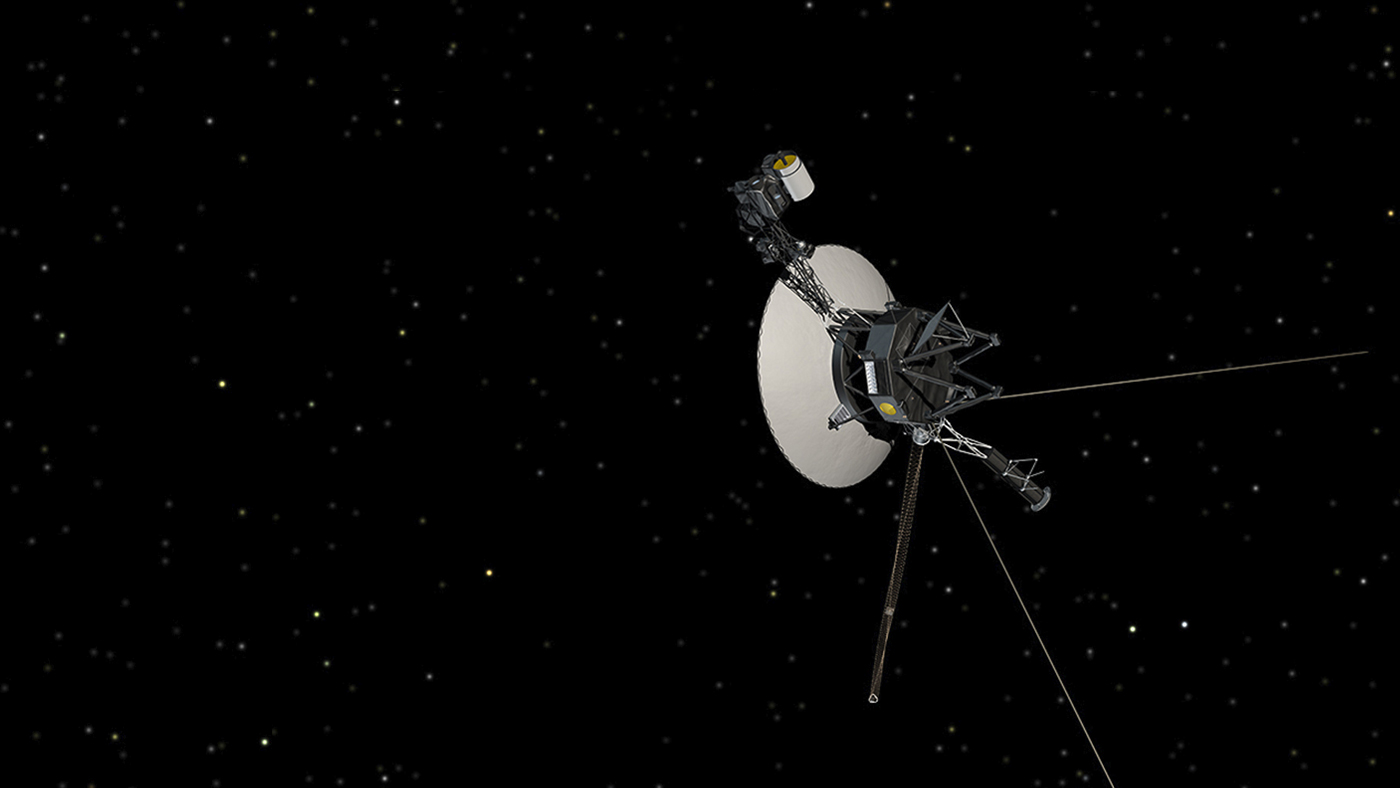
Between them, Voyager 1 and 2 explored all the giant planets of our outer solar system, Jupiter, Saturn, Uranus and Neptune; 48 of their moons; and the unique system of rings and magnetic fields those planets possess.
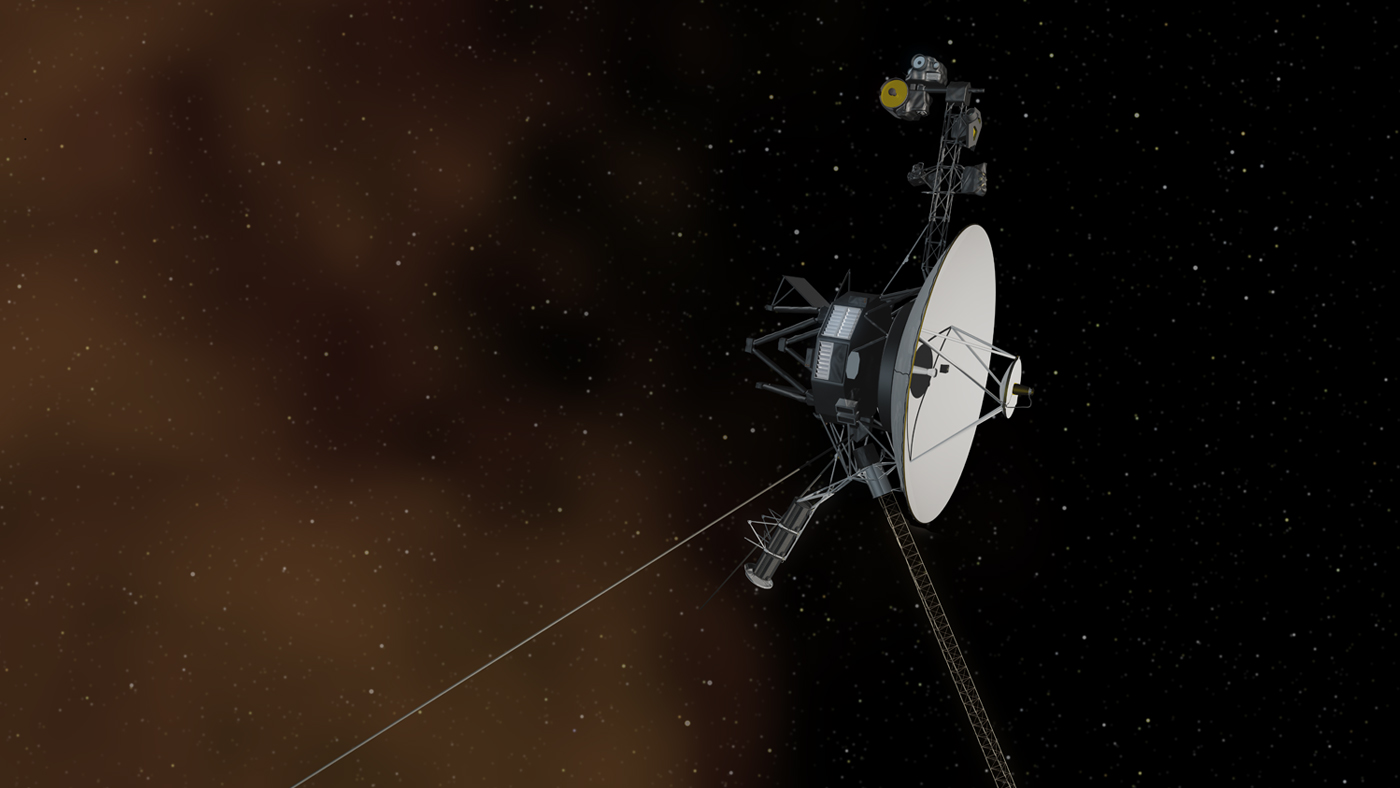
The Voyager spacecraft are the third and fourth human spacecraft to fly beyond all the planets in our solar system. Pioneers 10 and 11 preceded Voyager in outstripping the gravitational attraction of the Sun.
Voyager 1 crossed the termination shock in December 2004 at about 94 AU from the Sun while Voyager 2 crossed it in August 2007 at about 84 AU.
Both Voyager spacecrafts carry a greeting to any form of life, should that be encountered. The message is carried by a phonograph record - -a 12-inch gold-plated copper disk containing sounds and images selected to portray the diversity of life and culture on Earth.
In August 2012, Voyager 1 made the historic entry into interstellar space, the region between stars, filled with material ejected by the death of nearby stars millions of years ago. Voyager 2 entered interstellar space on November 5, 2018 and scientists hope to learn more about this region. Both spacecraft are still sending scientific information about their surroundings through the Deep Space Network, or DSN.
The primary mission was the exploration of Jupiter and Saturn. After making a string of discoveries there — such as active volcanoes on Jupiter's moon Io and intricacies of Saturn's rings — the mission was extended. Voyager 2 went on to explore Uranus and Neptune, and is still the only spacecraft to have visited those outer planets. The adventurers' current mission, the Voyager Interstellar Mission (VIM), will explore the outermost edge of the Sun's domain. And beyond.
Learn about Voyagers' mission status: where they are in the space, the time required to communicate with them, and a lot more.
Learn about the five science investigation teams, the four operating instruments on-board and the science data being returned to Earth.
The Voyager spacecraft have been exploring for decades. Dive deep into the journey with this interactive timeline.
Interact in 3D. Take a deeper look at the sophisticated systems and instruments that deliver the stunning science and images.
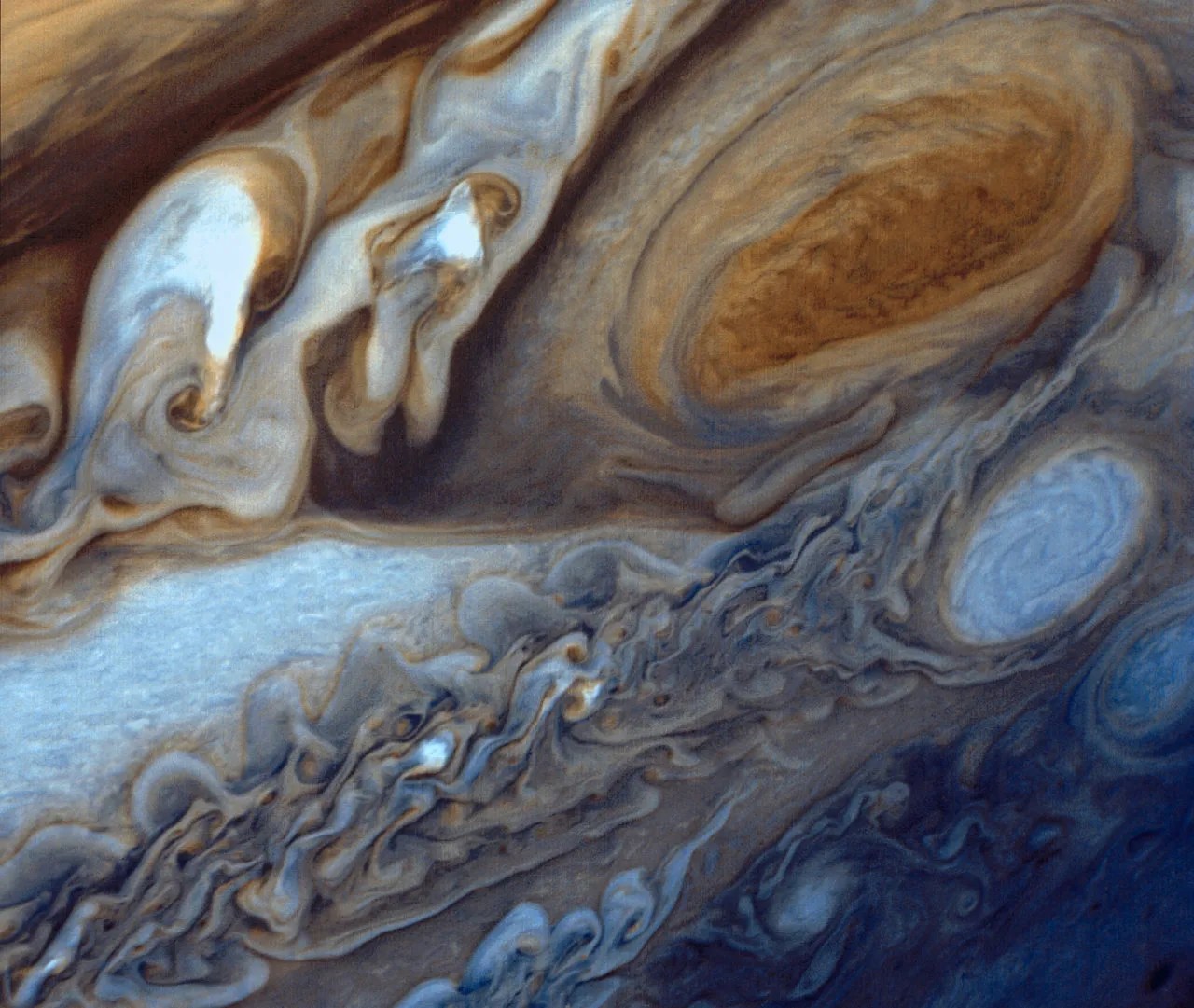
Interstellar Mission
The mission objective of the Voyager Interstellar Mission (VIM) is to extend the NASA exploration of the solar system beyond the neighborhood of the outer planets to the outer limits of the Sun's sphere of influence, and possibly beyond.
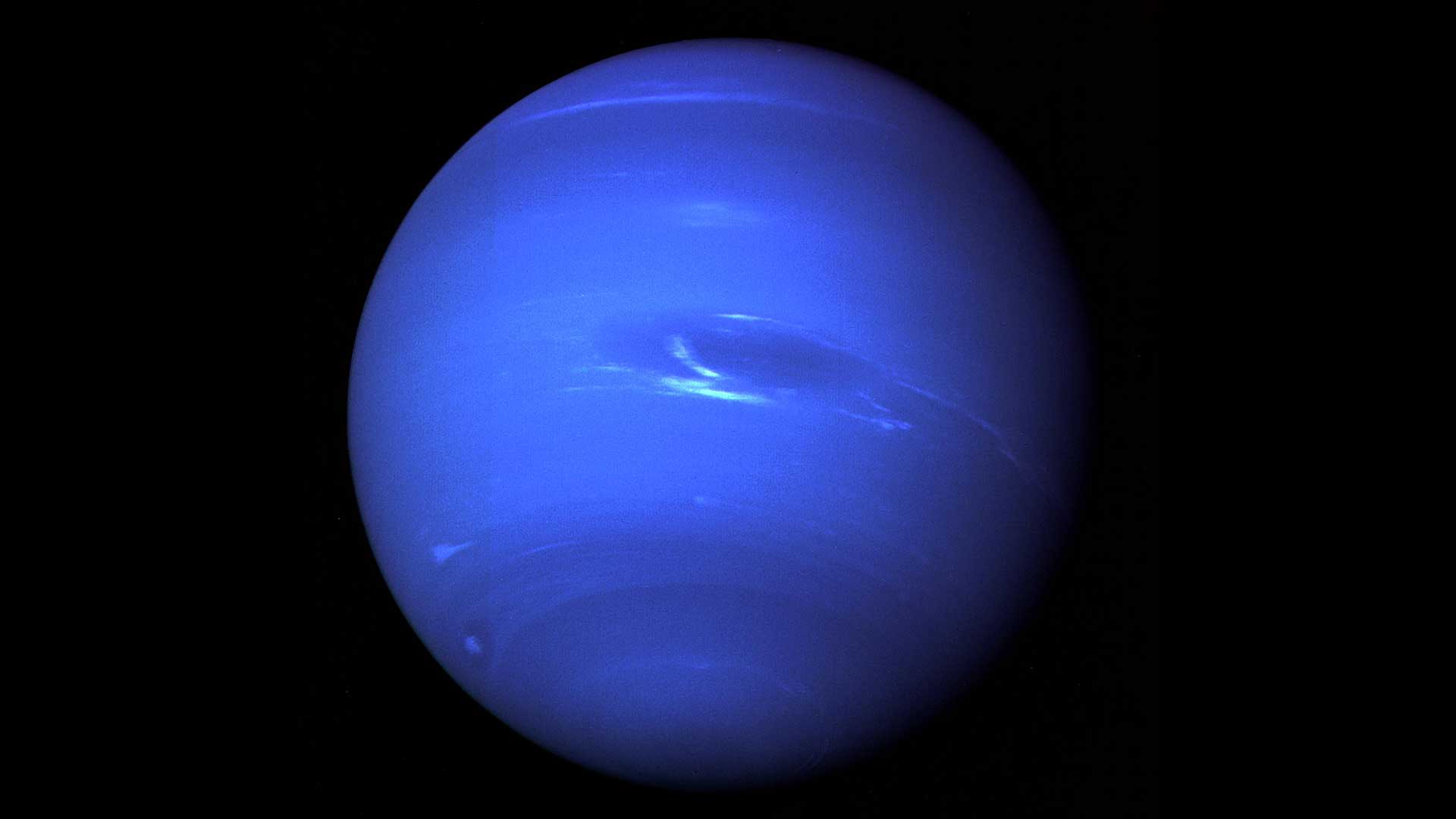
Planetary Voyage
The twin spacecraft Voyager 1 and Voyager 2 were launched by NASA in separate months in the summer of 1977 from Cape Canaveral, Florida. As originally designed, the Voyagers were to conduct closeup studies of Jupiter and Saturn, Saturn's rings, and the larger moons of the two planets.
Questions, answers and interviews that explain the Voyager mission.
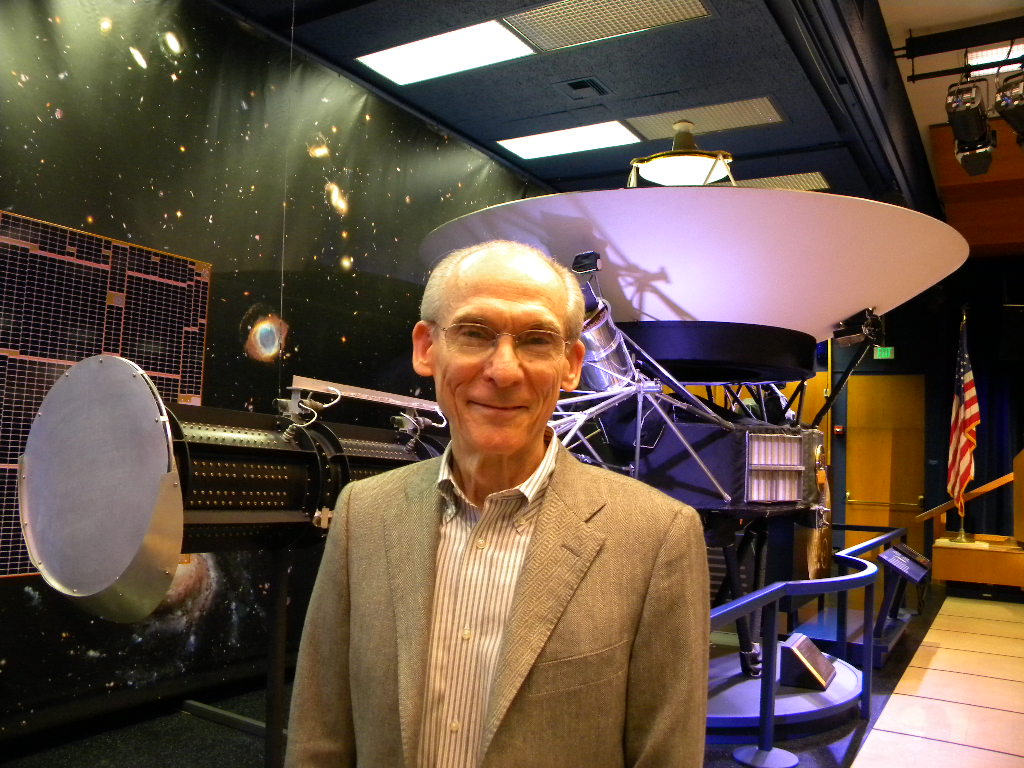
Updating the 'message in a bottle' to aliens: Do we need a new Golden Record?
A team of researchers thinks a 21st century upgrade is in order decades after nasa's twin voyager probes launched with a golden record to contact alien civilizations..

If an extraterrestrial species were ever to intercept the famed Golden Record blasted off decades ago into space, they'd be introduced to timeless elements of humanity and our existence on Earth: Sounds of rain drops and erupting volcanoes; powerful images of not only our planet, but others in our solar system; greetings recorded in 55 languages across the world.
Yet both copies of the Golden Record – each launched in 1977 aboard NASA's two Voyager spacecrafts – also contain some contents that are starting to show their age.
Jimmy Carter's time in the Oval Office has long since come to an end, despite the message from the former president in the capsule. Meanwhile, plenty of music has been released since Chuck Berry recorded Johnny B. Goode in 1958.
The original Golden Record may be an invaluable time capsule floating through the vast cosmos like a message in a bottle for aliens to find, serving as a symbol of both our own presence and also of our desire to know others.
But some scientists think a 21st century upgrade is in order.
A team of researchers at NASA's Jet Propulsion Laboratory in Pasadena, California recently set out to lay the groundwork for what a new edition of the Golden Record may look like. Envisioned as future cargo aboard an uncrewed interstellar spacecraft, the message could be intercepted by another advanced civilization, where it would showcase "the full richness and depth of human life and experience," the team wrote.
The academic article was published Dec. 4 in AGU Earth and Space Science.
"Our goal is to share our collective knowledge, emotions, innovations, and aspirations in a way that provides a universal, yet contextually relevant, understanding of human society, the evolution of life on Earth, and our hopes and concerns for the future," the team wrote in the paper.
Geminid Meteor Shower: The best time to see the Geminid meteor shower is this week. Here's how to watch.
What is the mission of NASA's Voyager probes?
The twin Voyager probes were launched on separate dates in 1977 from Cape Canaveral, Florida and have since traveled billions of miles away from Earth.
In 2012, Voyager 1 became the first spacecraft to reach interstellar space, followed in 2018 by Voyager 2, according to NASA .
Voyager's main mission is to explore the far reaches of our solar system ‒ and beyond. To that end, the spacecrafts have investigated all the giant planets of our outer solar system ‒ Jupiter, Saturn, Uranus and Neptune ‒ as well as the planets' magnetic fields and a combined 48 of their moons, NASA says .
But both Voyager 1 and 2 also carry a greeting to any form of life they may encounter called the Golden Record.
None other than famed American astronomer Carl Sagan chaired the committee tasked with selecting the contents of the message, contained on a 12-inch gold-plated copper disk. The phonograph records contain aspects that encapsulate life on Earth, such as samples of music from different cultures and eras, natural and man-made sounds from Earth , and electronic information encoded in analog form that an advanced civilization could convert into photographs .
"These records not only offer a snapshot of Earth and human civilization," the researchers wrote in the December paper, "but also represent our desire to establish contact with advanced alien civilizations.
What could be included in the new 'message in a bottle?'
Now, those researchers are wondering: What might a new edition of the Golden Record contain?
The team didn't endeavor to make any specific suggestions themselves this early on, but they did outline a broad vision in their self-described "message in a bottle" project. The authors wrote that some of the original record's contents wouldn't need an drastic overhaul – just a slight update to reflect our modern times.
The new message – sharing our biology, culture, knowledge and accomplishments – might also include newer forms of media and technology, including videos, games and even computer code, the researchers said.
The odds that an extraterrestrial race would find the message are slim, and the chances they'd be able to decipher its meaning? Even slimmer, the researchers admit.
To give Earthlings the best hopes of communicating with these theoretical alien beings, the researchers proposed creating a two-part message: For less-advanced civilizations, a scroll containing simple images illustrating humanity and Earth; and for a more-advanced species, a minicomputer containing a larger amount of digital information.
'Celebrate and safeguard our shared human experience'
The team hopes their proposal is a catalyst to raise public interest in their aims and solicit participation from people across the globe.
Despite the recent hoopla about UFOs and extraterrestrials , conclusive proof of otherworldly life remains frustratingly elusive . Whether aliens exist is one question, but whether they are aware of our presence ‒ or even care ‒ is entirely another.
While making first contact with an advanced extraterrestrial species is a worthwhile goal, the researchers also wrote that simply preserving a trace of human civilization for years and decades to come is just as important.
The team proposed that one version of the finalized message be sent into deep space, while another remain archived here on Earth for humans and other intelligent lifeforms to find in the distant future.
"Our intention extends beyond just establishing contact with distant civilizations," the team wrote. "We also strive to inspire and unify current and future generations to celebrate and safeguard our shared human experience."
Eric Lagatta covers breaking and trending news for USA TODAY. Reach him at [email protected]

Message in a Bottle (episode)
- View history
Seven of Nine finds an abandoned subspace relay network that has the ability to send a message, or in this case The Doctor, to a Starfleet ship detected in the Alpha Quadrant.
- 1.2 Act One
- 1.3 Act Two
- 1.4 Act Three
- 1.5 Act Four
- 1.6 Act Five
- 2 Memorable quotes
- 3.1 Story and script
- 3.2 Cast and characters
- 3.3 Production
- 3.4 Visual effects
- 3.5.1 Other Voyager episodes
- 3.5.2 Other series
- 3.5.3 Errors
- 3.6 Reception
- 3.7 Video and DVD releases
- 4.1 Starring
- 4.2 Also starring
- 4.3 Guest Stars
- 4.4 Special Guest Star
- 4.5 Co-Stars
- 4.6 Uncredited Co-Stars
- 4.7 Stand-ins
- 4.8.1 Dedication plaque references
- 4.8.2 Non-canon reference
- 4.9 External links
Summary [ ]
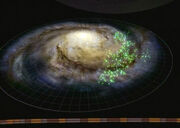
The Hirogen communications network
Lieutenant B'Elanna Torres and Commander Chakotay discuss Torres' dissatisfaction with the former Borg drone , Seven of Nine . Torres has run out of patience with Seven's aloof, arrogant attitude and is furious. Chakotay, on the other hand, doesn't want to hear it and advises her to start acting like the senior officer that she is. He orders her to find a way to deal with Seven in a professional manner.
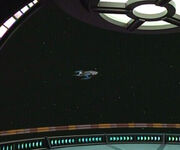
The detected Starfleet vessel, The USS Prometheus
While discussing this, Seven hails Chakotay to the astrometrics lab . Chakotay meets Captain Kathryn Janeway outside astrometrics. She too has been hailed by Seven. They share a bemused expression as they enter. Chakotay asks Seven, who is busy at the console, what this is about. She shows them a ship on the astrometrics viewscreen that is a Starfleet vessel.
Act One [ ]
Seven informs them that the ship is in the Alpha Quadrant . She informs them that she has been able to detect the ship because of the presence of a huge relay station network . The network is apparently abandoned but it extends all the way to the edge of the Alpha Quadrant. The ship, she tells them, is in range of the network sensors on that far end.
The two officers realize that they now have an opportunity to communicate with Starfleet, which they have not been able to do since being brought to the Delta Quadrant , four years earlier. Chakotay asks if a message can be sent to the ship. Seven confirms, though she adds that some modifications to their own transmitters must be made first. The message must be sent within the next 41 minutes or the ship will move out of range. Janeway orders the modifications be made immediately. However, the signal is too weak to reach the vessel. Lieutenant Tom Paris suggests using a stronger type of signal, one that would not degrade so quickly. Torres suggests a holographic data stream. That is when they remember The Doctor , the ship's Emergency Medical Hologram . Torres rushes to sickbay and, before The Doctor can even finish asking what is happening, she transfers him to his mobile emitter and runs with it to astrometrics. Janeway arrives in astrometrics and explains the situation to The Doctor when he is reactivated there. There, he is downloaded and transmitted.
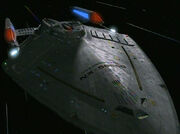
The USS Prometheus
The Doctor materializes on the Starfleet vessel's sickbay, which seems to be empty. He calls to anyone, but gets no answer. He queries the ship's computer and is very pleased to find that his transmission was successful; he is indeed aboard the target vessel, in the Alpha Quadrant. He further asks the ship's computer about the vessel's identity, and learns that it is the USS Prometheus .
Searching sickbay, he finds a crewman dead on the floor. He also finds an ensign , barely alive. Their uniforms are different from those of Voyager 's crew. The ensign has sustained severe phaser burns. The Doctor manages to revive him and asks him what happened. His response, just before he dies, is that Romulans have taken over the ship.
Act Two [ ]
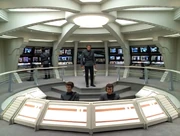
The Romulan hijackers
On the Prometheus ' bridge, Romulans man all stations. In sickbay, The Doctor confirms what the dead ensign told him: 27 Romulans are aboard and all Starfleet personnel are dead. He then asks the computer about the ship itself. He learns the ship is an experimental prototype designed for deep space tactical assignments. It is equipped with technologies that Starfleet is experimenting with including regenerative shielding , ablative armor , and a multi-vector assault mode .
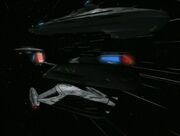
The Prometheus 's multi-vector assault mode
The approaching Federation starship arrives and engages the Prometheus . On the bridge, the Romulan commander orders the "multi-vector assault mode" engaged. The lighting on the bridge (and in sickbay, much to The Doctor's surprise) turns blue . The computer counts down from ten to one, the time of what it terms "auto-separation."
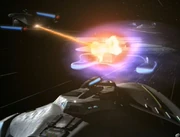
The Prometheus disables the Starfleet vessel
The ship separates into three sections: the saucer and two stardrives , all battle-ready and warp-capable . In effect, the one ship becomes a small squadron. Rekar orders the Prometheus to engage the other Federation ship, the USS Bonchune . The three sections surround and attack the Bonchune , disabling it. During the battle the Prometheus ' bridge takes a hit and a Romulan hijacker is badly injured. As the three sections reform, Rekar orders the injured Romulan taken to sickbay.
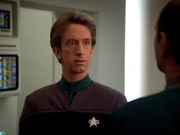
The Prometheus EMH encounters The Doctor
Nevala enters sickbay with her injured hijacker. The Doctor immediately puts on his best bedside manner. She is instantly suspicious, demanding to know who activated him. He lies that she did when she walked through the door. She is still suspicious because he is, after all, a Starfleet program. He assures her his primary directive is to treat anyone requiring it, Federation citizen or not, friend or enemy.
As soon as she has gone, The Doctor activates the ship's EMH – which is a Mark II, as opposed to a Mark I, The Doctor's designation.
Act Three [ ]
The Mark II stands in sickbay regarding The Doctor with contempt, calling him an inferior EMH program, much to The Doctor's chagrin, and tries to hail security . The Doctor immediately stops him and explains the situation of the Prometheus and of his own ship, Voyager . He explains Voyager is over 60,000 light-years away, and was pulled into the Delta Quadrant four years ago. With a forceful tone, he convinces his reluctant counterpart to help him take back the ship from the Romulans. He asks if the Federation is at war with the Romulans. The Mark II responds that they are not and the Romulans have had nothing to do with the Dominion War . Confused, The Doctor asks who the Dominion is but the Mark II tells him that it is a long story. They begin to treat the injured Romulan together.
Voyager holds position while the crew awaits The Doctor's return. Janeway and Chakotay write letters to their loved ones, though they know that The Doctor's return will not necessarily mean establishing a communications link with Starfleet. Paris has been assigned to sickbay until The Doctor's return as he is the only other trained medic aboard Voyager .
The Prometheus heads for Romulan space at warp speed . The Mark II informs The Doctor that the ship is capable of a cruising speed of warp 9.9 and no other ship in Starfleet can do this. Thus, there is no chance any Starfleet ship can intercept and rescue them meaning that they are on their own. They come up with a plan to take back the ship: release an anesthetic into the ventilation system .
Rekar orders a course change. They were previously headed for Romulus , but he has decided that they should instead rendezvous with the Tal Shiar , the intelligence service of the Romulan Star Empire . The others object and begin to argue with Rekar. During the argument The Doctor, pretending to scan them, surreptitiously attempts to access environmental controls. Rekar notices him and accosts him. Rekar then checks his scanner and sees that he has not scanned anything; his plan has been foiled.
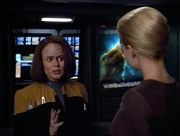
" You're rude. " Torres remonstrates Seven of Nine about the former drone's attitude
On Voyager , Seven of Nine enters astrometrics to find Torres there. They get into an argument in which Torres tells Seven that the way she speaks to other crewmembers is unacceptable.
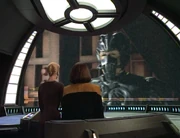
Voyager is warned to cut its link with the relay network
As Seven considers these comments, a transmission comes through. A humanoid alien 's image appears on the lab's viewscreen. The alien is wearing an armored helmet and an armored mask that covers his nose and mouth. He gruffly demands their identity. The man angrily tells them that the network is in fact, owned by the Hirogen . Torres apologizes and explains that they thought the network was abandoned. She attempts to explain why they are using it but he is not interested in her explanation and orders them to terminate their link before ending his communication.
Act Four [ ]
The Doctor is being interrogated by Rekar, who believes that The Doctor is either a spy or saboteur. Rekar does not believe a hologram to be capable of performing such action independently and he demands to know who is operating him. Nevana enters and reports that she has found the transmission log that shows when The Doctor came aboard. She notes that the transmission that brought him on board has a Starfleet signature.
The log does not indicate its origin or who sent it so they demand this information from The Doctor. He tells them part of the truth, that he was sent from the Delta Quadrant. Rekar and Nevala do not believe him and decide that stronger action is necessary. They will extract all his algorithms and analyze his subroutines individually. This action would severely damage or destroy his holomatrix , killing him. However they do not get beyond talking about it as they suddenly begin to cough and gag before collapsing, unconscious.
The Mark II materializes. He has succeeded in releasing the neurozine gas into the ventilation system. Their next step is to get to the bridge and turn the ship around. On the bridge, The Doctor finds a way to make the ship slow from warp speed but his method causes a warp core overload. Fortunately, he manages to stop the overload before a warp core breach occurs.
However after one disaster was averted, sensors indicate that three Romulan warbirds are headed straight toward them.
Meanwhile on Voyager , Seven and Torres work to reestablish the link with the Hirogen communications network in the astrometrics lab. Janeway has joined them to help with their work. Before they can finish, the Hirogen male appears again on the viewscreen. He introduces himself as Idrin and angrily reminds them of his initial warning to leave the network alone. Janeway tries to get him to listen, explaining that they are using it to get a message to their people but he is uninterested. He again proceeds to jam their link.
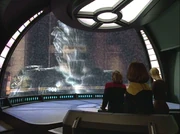
Idrin is shocked by Seven of Nine
Realizing that reasoning with Idrin won't work, Seven shocks him with a feedback surge along the link, knocking him out. Janeway orders them to keep watching for The Doctor's return and to alert her if the Hirogen troubles them again. With a stern look at Seven, she leaves the astrometrics lab. After making sure the captain is fully out of earshot, Torres tells Seven that she approved of her action and Seven casually thanks her.
In sickbay, Kim began programming the replacement EMH. He loads medical texts into the program, and the replacement EMH begins to recite Grey's Anatomy from chapter 1. However, the hologram overloads from all the data and crashes, deactivating it. Kim then downloads Grey's Anatomy for Paris to study himself.
Aboard the Prometheus , The Doctor and the Mark II try to get the ship moving again but without success. A hail comes from one of the warbirds. Keeping the viewscreen off, The Doctor answers, trying to fool them into thinking that he is the Romulan commander – he fails miserably. The warbirds open fire on the ship. The Prometheus ' regenerative shields rapidly begin to fail as the two holograms do not have the required expertise to operate them properly. Sensors detect more ships approaching.
The holograms are relieved to discover that the new ships are Starfleet vessels. The ships, two Defiant -class vessels and one Akira -class starship , are seen approaching at warp speed. They slow and join the fight but the holograms' relief quickly changes to horror when the Starfleet ships, instead of attacking the warbirds, fire on the Prometheus . The attempt to hijack the ship has been discovered by Starfleet Command .
Act Five [ ]
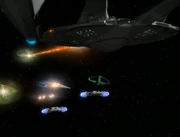
The battle for the Prometheus
The Mark II tries to hail the Starfleet ships but the Romulans hijackers scrambled the comm frequencies, making this impossible. The two holograms are left with no choice but to defend themselves. At first, they accidentally hit a Starfleet ship with a torpedo, but then they prove that the ship is no longer under enemy control by attacking the D'deridex -class . The Prometheus separates into its three battle-ready components. The three sections attack a warbird. With the computer in control, the power of the vessel is very effectively demonstrated against the targeted ship. The warbird is quickly destroyed and the other warbirds retreat. The Doctor and the Mark II grandiosely congratulate each other before being interrupted by two heavily-armed Starfleet security officers being beamed aboard.
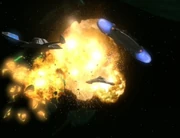
The Romulans are forced to retreat
In Voyager 's astrometrics lab, Seven of Nine detects a transmission coming through the relay network, from the Alpha quadrant. She informs Torres that the transmission has a holographic subroutine . Torres informs the bridge about the return of The Doctor.
Janeway, Chakotay, and Lieutenant Commander Tuvok arrive in sickbay as The Doctor materializes. He explains that he accomplished his mission and then gently informs Janeway that he spoke with Starfleet Command. Apparently, they had declared Voyager lost 14 months previously but he corrected that error, telling them that the ship is very much intact, and that the crew is searching for a way to return.
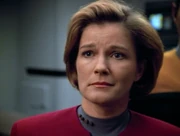
No longer alone
Starfleet will be contacting the crew's families to inform them of the news and have immediately begun to seek a way to retrieve them, and will not stop until they succeed in doing so. He ends by telling Janeway that Starfleet asked him to pass on a message: "You're no longer alone." Janeway emotionally remarks that after hearing this, "60,000 light years seems a little closer today."
Memorable quotes [ ]
" We need to take control of this situation! " " I'm a doctor, not a commando ! " " It's time you became a little of both. "
" Is the Federation at war with the Romulans? " " No. The Romulans haven't gotten involved in our fight with the Dominion. " " The who…?" " (Takes breath to explain, then pauses and changes his mind) Long story."
" What did you feed them anyway? " " Rodeo Red's Red-Hot, Rootin'-Tootin' Chili ."
" I have even had sexual relations. " " Sex, how's that possible? We're not equipped… " " Let's just say I made an addition to my program. "
" I'm a pilot, Harry, not a doctor ! "
" We're not afraid you're going to assimilate us, we're just not used to… you just… you're rude." " I am rude…"
" Four years ? No wonder you're delusional – your program's degrading after being active so long! " " I assure you, I am in perfect health! I was saving Voyager from annihilation when you were only a gleam in your programmer's eye! Now are you going to help me take back this ship or not!?" " (Pauses, then says with some gusto) Get me the thrombic modulator . "
" You are nothing but a computer-generated projection. I find it hard to believe you're capable of taking these actions independently. " " How flattering. " " Tell me who is operating your program. Is it someone on this ship? A Starfleet crew member we missed? Or one of my own men? " " Paranoia is a way of life for you, isn't it? "
" You know, you really should keep a personal log; why bore others needlessly? "
" Mild shock? Not bad! " " Thank you. "
" Stop breathing down my neck! " " My breathing is merely a simulation. " " So is my neck, stop it anyway! "
" Is this a thruster control? " " Don't touch it! We don't know what it does! It could be the self-destruct! "
" Beep beep beep, beep beep beep? I've never heard that one before. "
" The secondary gyrodyne relays in the propulsion field inter-matrix have depolarized. " " In English! " " I'm just reading what it says here! "
" Our viewscreen is non-operational. We've had some trouble with… Starfleet commandos… "
" Identify yourself. " " (whispering) You first. " " You first. "
" What are they doing?! " " Firing on us! " " They must think Romulans are on board! " " They're right! "
" You hit the wrong ship! " " It wasn't my fault! " " Well, then whose fault was it, the torpedo's?! You're supposed to tell it what to do! "
" My brilliant existence cut short… no time to explore the universe… no time to smell the roses… no time for…sex… "
" Doctor, we've done it! Two holograms alone, Romulans on one side, Starfleet on the other, alarms beeping everywhere! " " EMH Mark II; newborn but filled with courage! " " EMH Mark I; armed with years of experience! " " Together they emerge triumphant! " " The end. "
" You got through to Starfleet? " " I spoke directly with Headquarters. Apparently, Voyager was declared officially lost 14 months ago. I set the record straight. I told them everything that's happened to this crew. They said they would contact your families to tell them the news and promised that it may take years, but they won't stop until they find a way to get Voyager back home. And they asked me to relay a message. They wanted you to know you're no longer alone. " " 60,000 light years… seems a little bit closer today. "
Background information [ ]
Story and script [ ].
- Robert Picardo made some uncredited, humorous contributions to the script of this episode. Shortly before the end of Star Trek: Voyager 's fourth season , Picardo explained, " I have gotten into the habit of calling [episode writer] Brannon [Braga] with joke suggestions, and I scored pretty well on that particular episode. " ( Cinefantastique , Vol. 30, No. 9/10, p. 85) At about the end of the fifth season , Picardo commented, " I'm still phoning Brannon quite often with potential joke lines, although my record is still 'Message in a Bottle'. I think I had six jokes that were mine, in that episode. " ( Cinefantastique , Vol. 31, No. 11, p. 30) All six of these humorous suggestions were promptly approved for use in the installment. ( Star Trek Monthly issue 45 , p. 17) One specific instance of the suggested jokes was, as described by Picardo himself, "in the scene with […] EMH Mark-2… and my scripted line was 'Stop breathing down my neck.'" ( Star Trek: Voyager Companion (p. ? )) The actor recalled, " I said to Brannon, 'You know, we don't really breathe.' He said, 'It's just a Human expression.' It still troubled me. " ( Cinefantastique , Vol. 30, No. 9/10, p. 85) Picardo consequently requested the addition of two particular lines of dialogue. " I remember calling Brannon, " remarked Picardo, " and suggesting the following two rejoinders: EMH Mark-2 says, 'My breathing is merely a simulation.' To which The Doctor replies, 'So is my neck. Stop it anyway.' " ( Star Trek: Voyager Companion (p. ? ))
- Robert Picardo suspected that he may have influenced some of the episode's jokes without being told he had. " There are even sex jokes which I insist Brannon Braga stole from my convention material, " Picardo declared, " because I've been doing 10 minutes at conventions for a couple of years now about whether or not the holographic doctor is anatomically correct. " ( Star Trek Monthly issue 35 , p. 12)
- The episode's final scene was considerably altered; the scene was first shot in Voyager 's mess hall, with the ship's entire crew, but was subsequently reshot and relocated to sickbay. Explaining why the first version was not used, Robert Picardo stated, " It was too much. Originally, we had all these extras, and it was this big emotional moment. They decided it was too much like The Waltons . We ended up redoing that scene and keeping it small, just with Janeway, [Chakotay] and Tuvok. " ( Cinefantastique , Vol. 30, No. 9/10)
- The final draft of the episode's script was submitted on 26 September 1997 . [1]
- Mitch Suskin was of the opinion that this episode was reminiscent of Star Trek: The Original Series . " In my mind, " Suskin reckoned, " it was the closest thing to the spirit of some of the original Star Trek shows. " ( Cinefantastique , Vol. 30, No. 9/10, p. 80)
- This episode's ending is significant to Star Trek: Voyager in general. Robert Picardo noted of the episode, " Its conclusion kind of changed the tone of our journey […] It was a very important development for the series. " ( Star Trek Monthly issue 45 , p. 13) He also said, " It factored into a number of shows and storylines that came after it. " ( The Official Star Trek: Voyager Magazine issue 18 )
Cast and characters [ ]
- Actor Andy Dick was offered the role of the EMH Mark II after letting Brannon Braga (who was a friend of the performer) know that he would be interested in making an appearance on Star Trek: Voyager . Accounting for his acceptance of the role, Dick recalled, " It just seemed like such a great opportunity. I was a fan of Star Trek , but I'm not what you would call a regular viewer of any of the shows. I just thought it would be a challenge for me to do an episode. " ( The Official Star Trek: Voyager Magazine issue 18 )
- Andy Dick had many other friends who were excited to hear of his upcoming role. " I have many friends who watch the Star Trek shows religiously, " he explained. " They were all psyched when I told them that I was doing Voyager . " ( The Official Star Trek: Voyager Magazine issue 18 )
- Because Andy Dick (who was best known for playing the character of Matthew in NewsRadio ) was not entirely familiar with Star Trek , he prepared for his role here by watching some episodes. Robert Picardo explained, " Clearly he had not really seen the show before he got this episode, so he watched a few episodes and got an idea of the style of the show, because he's on a situation comedy […] And even though we were setting up to do a funny Star Trek episode, there's a certain style to our kind of performance that he wanted to acquaint himself with, which he [partly] did from watching the show. " ( Star Trek Monthly issue 35 , p. 11)
- Indeed, although Andy Dick found that he extremely liked his Voyager character, he also found that portraying the EMH Mark II took him into unfamiliar territory. " I was right in thinking it would be a challenge for me, " Dick admitted. " It was really an eclectic style of acting. It's like doing a French period drama and then doing Shakespeare . It was completely different from what I had done before. I mean, there's no comparing how we do NewsRadio to how they do Voyager . None […] The characters are so different, too […] As with Shakespeare, you have to stay within boundaries when you do a Star Trek show. The words are different; the style is different. I wanted to challenge myself and try that, too. " He joked, " It was really like taking a class in Trekker-ism. " ( The Official Star Trek: Voyager Magazine issue 18 )
- Other difficulties were caused by the fact that, although Andy Dick normally wore glasses (including on NewsRadio ), he found that he couldn't do so here. He said of his Voyager appearance, " One of the strangest things about doing it was that I couldn't wear my glasses […] I was tripping down steps and bumping into things all the time. It was really funny. " ( The Official Star Trek: Voyager Magazine issue 18 )
- On the other hand, Andy Dick appreciated that he was made to feel welcome on the Voyager set. He reminisced, " Everybody was really nice to me […] I had a great time. " ( The Official Star Trek: Voyager Magazine issue 18 )
- A particular relationship that Andy Dick valued was with Robert Picardo. " Robert Picardo was so awesome! " Dick raved. " He helped me so much, getting me to relax and helping me get that Star Trek jargon right. I don't think I could have pulled it off if he hadn't been there. Robert was hysterical. He's probably funnier than I am. He had me and the crew cracking up all day. " ( The Official Star Trek: Voyager Magazine issue 18 )
- Early in their working relationship, Robert Picardo and Andy Dick teased one another about each others' surnames. During production, Picardo remarked, " My favorite Andy Dick story is this. About three or four days into the shooting he says to me, 'So your name is Picardo. It's so close to Captain Picard . Do you get teased a lot about that?' And I said, 'Your name is Andy Dick, and you're going to make fun of mine?' So he laughed – apparently he has a sense of humor. I don't think you can grow up with a name like that and not have a healthy sense of humor. " ( Star Trek Monthly issue 35 , p. 11) In a retrospective interview, however, Picardo stated that the encounter in which they had traded barbs about one another's surname was "when I first met Andy" and, moments later, said, " That was our icebreaker, so […] after that, we would joke about anything. " ( Braving the Unknown: Season Four , VOY Season 4 DVD )
- Robert Picardo was somewhat worried about being reported to be bosom buddies with Andy Dick. " I remember saying to him, 'My biggest fear is that, when this episode airs, that TV Guide will do a little close-up box about it and it will say something like, 'Picardo and Dick a treat,' or, 'Picardo and Dick inseparable,' […] 'Picardo and Dick, together forever.' It just seemed… it seemed to give me a note of caution. However, I didn't follow it and I did tell the story. " ( Braving the Unknown: Season Four , VOY Season 4 DVD )
- Aside from the name-related jibes, Robert Picardo found that he enjoyed working with his co-star on this episode. Picardo commented that his own perception of Dick as "a bit of a loon […] appealed to me" and that, consequently, "we got along real well." Picardo went on to say about Dick, " He was very solicitous of my advice about the world of playing doctor holograms, what the conventions were, and how I said, 'Please state the nature of the medical emergency.' " Picardo also commented that Dick familiarized himself with the style of performance required on Star Trek by "asking me and the director questions." ( Star Trek Monthly issue 35 , p. 11)
- Initially, Robert Picardo was nervous about this episode's script. " That was one of our most overtly comic [episodes], " observed Picardo. " The whole second, third, and fourth acts with Andy Dick were quite funny, and intended to be funny. I'm always a little nervous when we try to do a funny script, because in my opinion Star Trek has never been known for its comedy […] The situations they put us in were funny, so there was a lot of high anxiety and panic. " ( Cinefantastique , Vol. 30, No. 9/10, p. 85)
- Ultimately, however, Robert Picardo was very pleased with the episode. He opined, " It did work out pretty well. " ( Cinefantastique , Vol. 30, No. 9/10, p. 85) He also stated, " 'Message in a Bottle' was […] very well done. It was quite a funny show, but its ending was quite serious […] It was an exciting show. " ( The Official Star Trek: Voyager Magazine issue 18 ) During the fifth season, Picardo enthused, " I loved that show. It was one of my favorites from last season. It contained a lot of humor, but was also very exciting and dramatic. " ( Star Trek Monthly issue 45 , p. 13) Additionally, Picardo considered this episode to be " a nice demonstration of how the writers can use me, and find ways to give me interesting and different things to do, within the given circumstances of this character. " ( Cinefantastique , Vol. 30, No. 9/10, p. 86)
- Robert Picardo was also proud of the breathing-related joke he devised for this episode, which he termed as both "the [joke suggestion] I'm proudest of" and "my favorite exchange that I have ever gotten into a show." ( Cinefantastique , Vol. 30, No. 9/10, p. 85; Star Trek: Voyager Companion (p. ? )) Picardo further commented, " I thought [it] sounded like two holograms bickering. 'What holograms bicker about.' That was a fun moment. " ( Cinefantastique , Vol. 30, No. 9/10, p. 85) Additionally, he remarked, " I thought it was a good example of a Niles / Frasier one-upmanship. " ( Star Trek: Voyager Companion (p. ? )) Picardo believed that such comparisons with those two main characters from the television series Frasier were warranted. He said of himself and Andy Dick, " We do have some very high-paced comedy scenes together, where we natter at each other, and it does sound a little Frasier -like. " ( Braving the Unknown: Season Four , VOY Season 4 DVD )
- The revised version of the episode's final scene was another highlight of the episode for Robert Picardo, who particularly enjoyed the performance that Janeway actress Kate Mulgrew delivered for the scene. Picardo commented, " That is a touching moment […] Kate's reaction was great, at the end. It is a moment of triumph. " ( Cinefantastique , Vol. 30, No. 9/10, pp. 85-86)
- Executive producer Jeri Taylor was highly amused by the pair of actors who played the holographic doctors here. She remarked, " [Andy Dick] and Robert Picardo together are just hysterical. " ( Star Trek Monthly issue 36 , p. 12)
- The two Starfleet officers beaming over to the bridge of the Prometheus near the end of this episode were played by two regular DS9 extras. This is probably because, unlike the Voyager extras, they were fitted with the latest Starfleet uniforms – the same type as can be seen worn by the other Starfleet officers aboard the Prometheus here, including the EMH Mark II.
Production [ ]
- The production of this episode was enjoyable for Andy Dick. " They work very hard on Voyager , " he observed. " Some days went as long as 16 hours. It was nice to be able to work hard, but also to laugh hard the whole day. " ( The Official Star Trek: Voyager Magazine issue 18 )
- There was some confusion during the production of "Message in a Bottle" concerning the registry of the Prometheus . According to Michael Okuda , he had used the number 74913 on all the internal displays and the ship's dedication plaque. However, the Foundation Imaging FX artists did not get the memo and used the number 59650 instead. [2] Although Okuda's number does appear on screen, the Foundation number is much more visible.
- According to the unauthorized reference book Delta Quadrant (p. 219), the bridge of the Prometheus was a redress of the USS Enterprise -E 's bridge.
- Visual effects supervisor Mitch Suskin was highly pleased with the sets for the Prometheus . " I think the art department did an amazing job on the interior of the Prometheus," Suskin remarked. ( Cinefantastique , Vol. 30, No. 9/10, p. 80)
- A shot that involved holographic appearances and disappearances being choreographed as different from how they usually were was one in which the EMH Mark II deactivates himself, duly disappears and Voyager 's Doctor moves into the area vacated by the Mark II, who then – reactivated by Voyager 's Doctor – reappears in the background. " Obviously, in production Andy [Dick] dropped out of frame, ran around to the background, and continued the scene, " Mitch Suskin explained. " But this kind of staging makes the shot more fun and more satisfying. " ( Cinefantastique , Vol. 30, No. 9/10, p. 80)
- Tiny Ron ( Idrin ) is better known for his role as Maihar'du , the Hupyrian servant of Grand Nagus Zek , in Star Trek: Deep Space Nine .
Visual effects [ ]
- The exterior of the Prometheus was designed by senior illustrator Rick Sternbach . This was the first episode to feature CGI versions of the D'deridex -class Romulan Warbird , which CGI supplier Foundation Imaging built as a digital model especially for this episode. To visualize the pair of Defiant class ships that are shown here, the visual effects artists borrowed a digital model of the Defiant from Digital Muse . That company also produced the astrometrics graphics of this episode, the creation of which constituted a considerable challenge. Much of the episode's visual effects work involved adding the appearances and disappearances of the two holographic doctors (effects that Mitch Suskin described as the holograms "zimmering in and out"). ( Cinefantastique , Vol. 30, No. 9/10, pp. 80 & 81)
- The effect of Voyager 's Doctor being sent between the Alpha and Delta Quadrants was done at POP Film and POP Animation . Mitch Suskin recalled, " It was a 3-D mannequin that was rendered on a Macintosh , [with] a lot of compositing bay futzing around to get the whole thing put together. Obviously it needed to have some connection to the hologram universe of Star Trek and the zimmer, but we wanted it to have a different look and to get the idea that he was being compressed. " ( Cinefantastique , Vol. 30, No. 9/10, p. 81)
- Mitch Suskin was ultimately very proud of the visual effects in this episode. " I think that of all the things we've done, there was the best balance between all of the elements in the show. " Suskin went on to explain that he thought the installment's effects shots complement the episode and are all necessary, rather than standing out, gratuitously overwhelming the installment. ( Cinefantastique , Vol. 30, No. 9/10, p. 81)
Continuity and trivia [ ]
- This episode does not give a stardate. The EMH Mark II mentions, however, that Romulans have not yet joined the Federation Alliance in the war effort against the Dominion, placing this episode before the Star Trek: Deep Space Nine episode " In the Pale Moonlight ". The events of that episode take place in the two weeks leading up to the stardate 51721.3, placing it between the later fourth-season Voyager episodes " The Killing Game, Part II " and " Vis à Vis ".
- This episode marks the first appearance of the Hirogen on the series.
- This episode establishes that Voyager was officially declared lost fourteen months before the events of this episode, which is approximately at the beginning of Star Trek: Voyager 's third season .
- Although the Dominion is referenced in several other episodes, this is the only one to reference the Dominion War and includes the only direct mention of the Dominion on the series. This makes sense, since Voyager was stranded in the Delta Quadrant long before the start of the Dominion War, remained there for its duration and did not return until after the war had ended.
- As of this episode, The Doctor becomes the first member of the Voyager crew to return to the Alpha Quadrant in the 24th century . He does this again in the Season 6 episode " Life Line ", to heal Dr. Lewis Zimmerman . In the third season two-parter " Future's End " and " Future's End, Part II ", the entire crew return to Earth ; but to the year 1996 . Also, Harry Kim "returns" to Earth in the second season episode " Non Sequitur ", but in an alternate timeline due to an alien race's interference. Harry and Chakotay return to the Alpha Quadrant during " Timeless "; however, the slipstream accident, and the subsequent timeline is excised due to future-Kim's actions in 2390 .
- The Starfleet task force destroys a D'deridex Warbird for the first time on screen.
- This is the first appearance of EMH Mark II; its conception and first stages of programming were seen in DS9 : " Doctor Bashir, I Presume " with the LMH ; in that episode Julian Bashir was considered to serve as the template for its prototype, until Dr. Lewis Zimmerman abandoned the idea.
- This episode marks the first appearance of the new Starfleet uniform on the series (unless you count the "flashbacks" in the earlier fourth season episode " Random Thoughts "), which had been introduced the previous year in Star Trek: First Contact and made their Star Trek: Deep Space Nine appearance in " Rapture ". From this point on, all Starfleet characters in the Alpha Quadrant wear this style of uniform, although the Voyager crew members themselves continued to wear the old style , due to being stranded in the Delta Quadrant .
- The two Starfleet officers who transport onto the Prometheus ' bridge, in this episode's conclusion, carry Voyager -style compression phaser rifles , one of the few times that Alpha Quadrant personnel are seen with these weapons.
- This is the second time that Judson Scott has portrayed a character who commandeers a Starfleet ship. He previously played the (uncredited) role of the Augment Joachim who assisted Khan Noonien Singh in hijacking the USS Reliant in Star Trek II: The Wrath of Khan .
- A map depicting the Prometheus flight path, "heading straight for Romulan space", shows it crossing a thin elongated area. This might have been intended to be the Romulan Neutral Zone , though it was not mentioned in the episode.
- References to 47 : Voyager 's coordinates are given as "18 mark 205 mark 47", and an attack pattern "beta four seven" is used.
- Neelix states that "when we get back to earth, I want to make sure I have marketable job skills", confirming for the first time that he intends to stay with Voyager all the way to Earth, even though this would put him 80,000 light years away from his homeworld and any of his species.
Other Voyager episodes [ ]
- This is the eighth time the crew of Voyager discover a direct connection between the Alpha Quadrant and Delta Quadrant, having previously discovered a wormhole connecting the two quadrants (" Eye of the Needle "), descendants of human abductees (" The 37's "), descendants of aliens who have visited Earth (" Tattoo "), a Cardassian weapon (" Dreadnought "), Ferengi (" False Profits "), former Borg that were assimilated in the Alpha Quadrant (" Unity "), and descendants of Earth dinosaurs (" Distant Origin "). In this episode, they find a communications network that extends far enough to overlap the Alpha Quadrant.
- The Doctor's message at the end of this episode seems to suggest that the Romulan Telek R'Mor from the first season installment " Eye of the Needle " did not, or could not, make arrangements to send Voyager 's personal letters to their families, in 2371, after his death in 2367, which would have informed Starfleet of the ship's location in the Delta Quadrant.
- When talking with The Doctor, EMH Mark II addresses the problem of memory degradation when an EMH is online longer than it was designed for. The Doctor has faced this condition in " The Swarm ".
- The Doctor also mentions to Mark II that he has, at one point, engaged in sexual relations. Robert Picardo was informed – during the fourth season – that the reference was meant to be to Danara Pel (in the second season episode " Lifesigns "). The Doctor also had possible affairs with Freya (in the first season installment " Heroes and Demons ") and/or his holographic wife (in Season 3's " Real Life ").
- Harry Kim's failure to successfully program a replacement EMH in this episode is seemingly reversed just a season later , in the episode " Nothing Human ". It is never made clear how Harry gained the knowledge to so quickly succeed with the Crell Moset hologram where he had struggled and failed with the EMH replacement. Perhaps his failure in this episode motivated him to rapidly increase his knowledge of holoprogramming, or it may be simply easier to duplicate and build from an existing personality rather than trying to reconstruct an entire artificial personality.
- The EMH Mark II has the ability to deactivate himself, while Voyager 's EMH had to be reprogrammed in order to do so, as mentioned in the first-season episode " Eye of the Needle ".
- After its introduction in this episode, the Prometheus -class of starship went on to reappear in Star Trek: Voyager 's series finale, " Endgame "
- The Doctor, when presented with the opportunity to travel to the Alpha Quadrant, says "far be it from me to turn down an opportunity to become a hero". This may be a reference to the first-season episode " Heroes and Demons ", in which he takes the role of a herioc character in a holodeck recreation of Beowulf and protects Voyager from a real alien threat.
- The Doctor is asked by the EMH Mark II to pick up a medical device, but, not familiar with the advanced devices, picks the wrong one. This is something of a reversal of a scene in the series premiere " Caretaker ", in which Paris fails to provide the correct tricorder and The Doctor becomes frustrated.
- On writing letters home, Captain Janeway points out that "it's probably a mistake for us to get our hopes up at all. we've been through this before". This is a reference to " Eye of the Needle ", in which the crew write letters home to be sent through a wormhole to the alpha quadrant, only to find the wormhole's exit was 20 years in the past.
Other series [ ]
- The Doctor's retort to Rekar's threat of de-activation – specifically that, since he would be "killed" whether he assisted the Romulans or not, he had no intention of helping them – is the same explanation Spock gives to Sela in a similar situation in TNG : " Unification II ".
- As well as appearing in the series finale, the Prometheus -class of starship is also seen in the Star Trek: Enterprise episode " Azati Prime ", in a scene where Captain Archer visits the 26th century.
- Due to a production error, the main viewscreen of the Prometheus twice shows a stationary starfield despite the fact that the ship is meanwhile widely regarded as traveling at high warp. " On the viewscreen are standard stars, there are no warp stars, " commented Mitch Suskin of the two erroneous shots. " It was something that was missed in production, and because both of the sequences involve moving camera, the difficulty and expense putting warp stars in there would have been prohibitive. It was decided, obviously wisely by the producers, that no one would probably notice anyway, or we would just make the conclusion that there was some technological reason on this advanced ship that we weren't seeing stars. " ( Cinefantastique , Vol. 30, No. 9/10, p. 81)
- When The Doctor left Voyager , his mobile emitter disappeared, despite the fact that it would not be capable of being uploaded.
- The Doctor states that Voyager was brought into the Delta Quadrant "four years ago", suggesting the events of this episode take place in 2375 rather than 2374. The episode however makes it clear that it takes place before the events of the Star Trek: Deep Space Nine episode " In the Pale Moonlight ", as the Romulans are not yet involved in the Dominion war.
- The Doctor does not seem to know about the Dominion. However, the Federation was aware of the Dominion's existence since mid- 2370 , as is established in DS9 : " Rules of Acquisition ", and the Dominion were encountered in DS9: " The Jem'Hadar " and " The Search, Part I ", months before Voyager 's departure. The Doctor's program, however, may not have been updated with information on the Dominion before being stranded in the Delta Quadrant.

Reception [ ]
- This episode was Mitch Suskin's favorite installment of Star Trek: Voyager 's fourth season. " 'Message in a Bottle' I'm most pleased with, " he said, " because it was a really funny story. " ( Cinefantastique , Vol. 30, No. 9/10, p. 80)
- This episode achieved a Nielsen rating of 4.2 million homes, and a 7% share. [3] (X)
- Both of the episode's two lead actors perceived this episode as being a fairly popular one. Shortly after working on the installment, Andy Dick stated, " As far as I know, people liked the episode. I've gotten positive feedback from everyone I've spoken to and, from what I understand, the fans liked it, which is the most important thing. " ( Star Trek Monthly issue 41 , p. 61) Robert Picardo later cited this as one of two episodes from the fourth season that he knew had been favorites of fans on the Internet (the other such outing being " Living Witness "). ( Star Trek Monthly issue 45 , p. 16)
- One controversial element of this episode was its use of two Defiant -class ships, as many fans had previously believed that the USS Defiant was the only ship of its class, despite other Defiant -class starships appearing in shots of the Second Fleet in " Call to Arms ". The question of how many Defiant -class ships there were was therefore a topical discussion point, both on the Internet and among some of the makers of Star Trek themselves. ( Cinefantastique , Vol. 30, No. 9/10, p. 80) This issue was later directly addressed in the episode " Valiant ", with confirmation that Starfleet had put the class into full production during the Dominion War .
- Robert Picardo was extremely pleased that the relationship between his own character of The Doctor and the EMH Mark II was publicized as being similar to the bond between Frasier and Niles Crane. The actor remembered, " When the [ Voyager ] show aired, we got a review in USA Today that called Andy Dick and I the 'Frasier and Niles of outer space' […] Because I love that show and both those actors, I thought that was about the highest compliment we could have gotten. " ( Braving the Unknown: Season Four , VOY Season 4 DVD )
- Cinefantastique rated this episode 3 out of 4 stars. ( Cinefantastique , Vol. 30, No. 9/10, p. 95)
- Star Trek Monthly issue 41 , p. 60 scored this episode 4 out of 5 stars.
- The unauthorized reference book Delta Quadrant (p. 221) gives the installment a rating of 10 out of 10.
- After having appeared in this episode, Andy Dick felt he had learned how to handle the technobabble of Star Trek . " I can now talk pretty convincingly about Romulans and holoemitters and starships, " he said, shortly after the episode's production. He was also very open to the possibility of returning to Star Trek . " Oh, I would totally do it again! " he enthused, before saying of his many friends who watched Star Trek , " Now they're telling me that I would make a great Ferengi on Deep Space Nine . " He concluded, " I would love to do Star Trek again. I'm just sitting here right now, waiting for the phone to ring. If they came up with another show as good as that, I'd be there in a minute. " ( The Official Star Trek: Voyager Magazine issue 18 ; Star Trek Monthly issue 41 , p. 61)
- Robert Picardo was under the erroneous impression that, upon the series finally depicting Voyager 's return home, the plot point about The Doctor achieving the first contact with Starfleet here would, in his words, "come back and resonate." ( Star Trek Monthly issue 45 , p. 13)
Video and DVD releases [ ]
- UK VHS release (two-episode tapes, CIC Video ): Volume 4.7, catalog number VHR 4628, 6 July 1998
- As part of the VOY Season 4 DVD collection
Links and references [ ]
Starring [ ].
- Kate Mulgrew as Captain Kathryn Janeway
Also starring [ ]
- Robert Beltran as Chakotay
- Roxann Dawson as B'Elanna Torres
- Robert Duncan McNeill as Tom Paris
- Ethan Phillips as Neelix
- Robert Picardo as The Doctor
- Tim Russ as Tuvok
- Jeri Ryan as Seven of Nine
- Garrett Wang as Harry Kim
Guest Stars [ ]
- Judson Scott as Rekar
- Valerie Wildman as Nevala
Special Guest Star [ ]
- Andy Dick as EMH Mark II
Co-Stars [ ]
- Tony Sears as Starfleet Officer
- Tiny Ron as Hirogen
- Majel Barrett as Computer Voice
Uncredited Co-Stars [ ]
- John Austin as operations division officer
- Richard Bishop as operations division officer
- Lynne Burnett as Romulan officer
- Brian Donofrio as science division officer
- Kevin Finister as operations division officer
- Holiday Freeman as an operations division officer
- Dianne Harper as dead Prometheus officer
- Todd Leatherbury as Starfleet security officer
- Angus McClellan as Starfleet security officer
- Ty Murphy as Romulan officer
- Joey Sakata as science division officer
- Lydia Shiferaw as command division officer
- Deborah Stiles as command division lieutenant j.g.
- Unknown actor as Almak (voice)
Stand-ins [ ]
- Cameron – stand-in for Jeri Ryan
- Brian Donofrio – stand-in for Robert Beltran
- Tarik Ergin – stand-in for Judson Scott
- Sue Henley – stand-in for Kate Mulgrew
- James – stand-in for Ethan Phillips
- Susan Lewis – stand-in for Roxann Dawson and Valerie Wildman
- Lemuel Perry – stand-in for Tim Russ and Tony Sears
- J.R. Quinonez – stand-in for Robert Picardo
- Keith Rayve – stand-in for Robert Duncan McNeill and Andy Dick
- John Tampoya – stand-in for Garrett Wang
- Stand-in for Tiny Ron
- Hand double for Andy Dick
- Hand double for Robert Picardo
References [ ]
2371 ; 2373 ; 29th century ; 47 Tucanae ; ablative armor ; Akira -class ( unnamed ); algorithm ; algorithm extraction ; Alpha Quadrant ; American cuisine ; analytical subroutine ; anesthetic ; anesthazine ; animal ; antacid ; assimilation ; Astrometrics ; attack formation ; attack pattern ; axonol ; bearing ; bedside manner ; biofilter ; biohazard ; Bonchune , USS ; Borg space ; brig ; carrier wave ; Cat's Eye Nebula ; cell ; cell coil ; Chakotay's cousin ; chicken salad ; Comparative Alien Physiology ; compression phaser rifle ; cone ; convention ; coordinates ; couch ; cousin ; cramps ; cytoplasm ; D'deridex -class ; dedication plaque ; deep space mission ; Defiant -class ( unnamed ); delirium ; Delta Quadrant ; distress signal ; Dominion ; Dominion War ; Eagle Nebula ; Earth ; Emergency Medical Hologram ; Emergency Medical Hologram Replacement Program ; English language ; exoscalpel ; Federation ; feedback surge ; field test ; flattery ; gas ; Gray's Anatomy ; gyrodyne relay ; hair ; heartburn ; hijacking ; Hirogen ; Hirogen communications network ; holodeck ; holoemitter ; holo-engineer ; holo-shuttle ; holographic data stream ; holographic subroutine ; holomatrix ; holotechnology ; initiation code ; intercept course ; interlink frequency ; intruder alert ; jalapeño ; jamming signal ; Janeway family ; jaw ; Jefferies tube ; job skill ; Johnson, Mark ; leech ; lie ; life support ; maneuvering thruster ; McCoy, Leonard ; medical expert ; medical library ; medical tricorder ; membrane ; mobile emitter ; multi-vector assault mode ; nacelle power control ; navigational log ; Nebula -class ; neurozine ; nuclei ; Ohio ; operative ; Ops console ; optronic data stream ; osteogenic stimulator ; ovum ; paranoia ; personal grooming ; personality profile ; personal log ; phaser burn ; physical characteristic ; prisoner ; programmer ; Prometheus , USS ; Prometheus -class ; propulsion field intermatrix ; psychotropic agent ; rash ; referee ; regenerative shield ; Rodeo Red's Red-Hot, Rootin'-Tootin' Chili ; Romulan ; Romulan Neutral Zone ; Romulan space ; Romulan Warbird ; Romulus ; schematic ; senior officer ; sex (aka sexual relations ); shape ; sickbay ; smell the roses ; speech recognition protocol ; spherical ; Starfleet ; Starfleet Headquarters ; Starfleet uniform (2370s-early 2380s) ; stomach ; stone face ; strain ; Tal Shiar ; Terothka virus ; Terrellian plague ; thrombic modulator ; thrust initiator ; thruster control ; tissue ; T'Met ; T'Met 's sister ships ; Veil Nebula ; ventilation system ; viewscreen ; vocal subroutine ; Voyager 's chief medical officer ; warbird, Romulan ; warp core ; warp field ; warp signature ; warp trail
Dedication plaque references [ ]
Agalsoff, Greg ; Antares sector ; Berman, Rick ; Bernard, Alan ; Berry, Greg ; Beta Antares Ship Yards ; Betts, Ben ; Biller, Ken ; Blackman, Bob ; Braga, Brannon ; Brownfield, Dick ; Burgess, Randy ; chief of staff ; Curry, Dan ; Davis, Meril ; dedication plaque ; DeMeritt, Michael ; Djanrelian, Jon ; Dorton, Louise ; Drapanas, Wendy ; Eyslee, Bob ; Farrell, J.P. ; Fleck, Jerry ; Fukai, Arlene ; Genovese, Cosmo ; Hester, Rick ; Hooper, Greg ; Howard, Merri ; James, Richard ; Karnes, Amanda ; Lauritson, Peter ; Menosky, Joe ; Middleton, Scott ; Okuda, Michael ; Overdiek, Diane ; Peets, Bill ; registry ; Research & Development ; Roddenberry, Gene ; Rush, Marvin ; Russo, Charlie ; Science Ops ; Shakespeare, William ; Simmons, Adele ; Smutko, Alex ; Spencer, Kim ; Starfleet Command ; Starfleet Ops ; Sternbach, Rick ; Stimson, Mark ; Suskin, Mitch ; Tactical Ops ; Taylor, Jeri ; Thoms, Wil ; Vholia, Pat ; Westmore, Mike ; Yacobian, Brad
Non-canon reference [ ]
Spector , USS
External links [ ]
- "Message in a Bottle"" at StarTrek.com
- " Message in a Bottle " at Memory Beta , the wiki for licensed Star Trek works
- " Message in a Bottle " at Wikipedia
- 3 Ancient humanoid
Astronomy Picture of the Day
- The Original Series
- The Next Generation
- Deep Space Nine
- Strange New Worlds
Et in Arcadia Ego, Part 2
People of earth.

Message in a Bottle
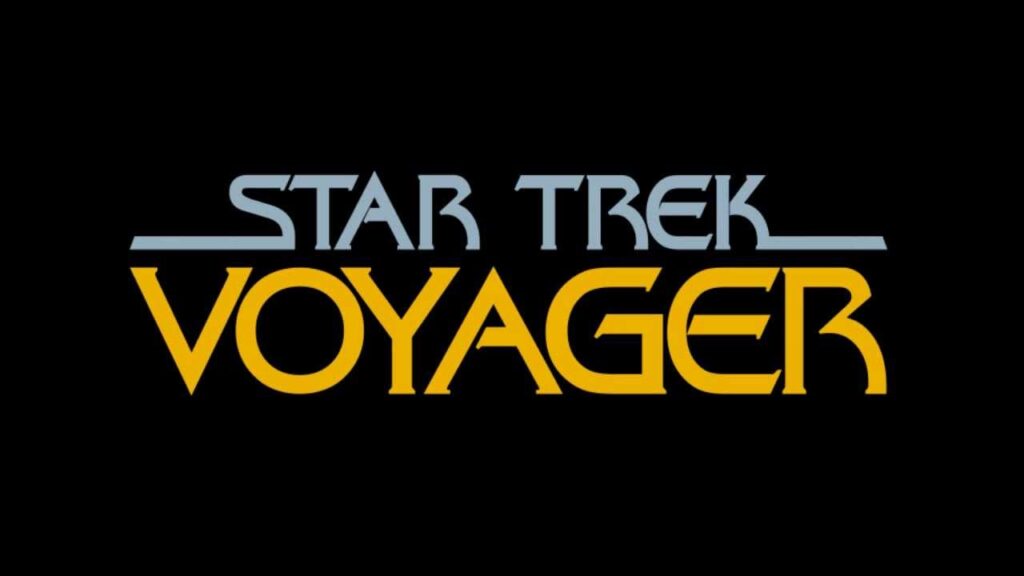
Voyager, lost in the unexplored reaches of the Delta Quadrant, has been searching for a way back to the Alpha Quadrant for years. In the episode “Message in a Bottle,” their efforts take an unexpected turn when they pick up a faint Starfleet signal from a distant planet.
The source of the signal is the emergency medical hologram, or EMH, from the Starship Prometheus. The crew of Voyager rushes to the planet to investigate, and they find that the Prometheus has been destroyed. But the EMH, programmed with a failsafe routine, has continued to run for the past four years.
The EMH explains that the Prometheus was attacked by a race of aliens known as the Romulans, who had come to the Delta Quadrant to capture a prototype of a advanced experimental ship, the X-Shuttle. The shuttle, however, was never found and the Romulans instead destroyed the Prometheus and the crew.
The EMH tells the crew of Voyager that there may be a way for him to send a message to the Alpha Quadrant by using a prototype communications device that was intended to be used to send messages between galaxies. The device had been installed on the Prometheus, but was never used because the Romulans arrived before it could be tested.
The EMH, with the help of Voyager’s crew, is able to modify the communications device to broadcast a message to any Starfleet vessel within range. Knowing the message will take months to reach the Alpha Quadrant, the crew of Voyager must devise a plan to protect the EMH in the meantime.
The crew of Voyager is able to defend the EMH from the Romulans and destroy their fleet, allowing the message to be sent. This message is the first communication with Starfleet they have had in years, and it brings hope to the crew of Voyager that one day they may be able to return home.
The episode ends with the EMH remaining on the planet to continue his mission in the Delta Quadrant. He brings a message of hope to Voyager; even when things seem their darkest, the power of a message in a bottle can provide a spark of hope and the possibility of a better future.
Related Posts
Equinox (part 2), persistence of vision.
Type above and press Enter to search. Press Esc to cancel.
NASA engineers discover why Voyager 1 is sending a stream of gibberish from outside our solar system
Voyager 1 has been sending a stream of garbled nonsense since November. Now NASA engineers have identified the fault and found a potential workaround.
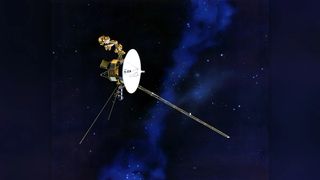
For the past five months, the Voyager 1 spacecraft has been sending a steady stream of unreadable gibberish back to Earth. Now, NASA engineers finally know why.
The 46-year-old spacecraft sends regular radio signals as it drifts further from our solar system . But in November 2023, the signals suddenly became garbled, meaning scientists were unable to read any of its data, and they were left mystified about the fault's origins.
In March, NASA engineers sent a command prompt, or "poke," to the craft to get a readout from its flight data subsystem (FDS) — which packages Voyager 1's science and engineering data before beaming it back to Earth.
After decoding the spacecraft's response, the engineers have found the source of the problem: The FDS's memory has been corrupted.
Related: NASA's Voyager 1 sends readable message to Earth after 4 nail-biting months of gibberish
"The team suspects that a single chip responsible for storing part of the affected portion of the FDS memory isn't working," NASA said in a blog post Wednesday (March 13) . "Engineers can't determine with certainty what caused the issue. Two possibilities are that the chip could have been hit by an energetic particle from space or that it simply may have worn out after 46 years."
— NASA hears 'heartbeat' signal from Voyager 2 probe a week after losing contact
— Historic space photo of the week: Voyager 2 spies a storm on Saturn 42 years ago
— NASA reestablishes full contact with Voyager 2 probe after nail-biting 2-week blackout
Although it may take several months, the engineers say they can find a workaround to run the FDS without the fried chip — restoring the spacecraft's messaging output and enabling it to continue to send readable information from outside our solar system.
Sign up for the Live Science daily newsletter now
Get the world’s most fascinating discoveries delivered straight to your inbox.
Launched in 1977, Voyager 1 zipped past Saturn and Jupiter in 1979 and 1980 before flying out into interstellar space in 2012. It is now recording the conditions outside of the sun's protective magnetic field , or heliosphere, which blankets our solar system.
Voyager 1 is currently more than 15 billion miles (24 billion kilometers) from Earth, and it takes 22.5 hours for any radio signal to travel from the craft to our planet.

Ben Turner is a U.K. based staff writer at Live Science. He covers physics and astronomy, among other topics like tech and climate change. He graduated from University College London with a degree in particle physics before training as a journalist. When he's not writing, Ben enjoys reading literature, playing the guitar and embarrassing himself with chess.
NASA spacecraft snaps mysterious 'surfboard' orbiting the moon. What is it?
The moon is getting its own time zone, White House memo to NASA reveals
Why I watched the solar eclipse with my kids, a goose and 2,000 trees
- TorbjornLarsson Bon voyage, Voyager! Reply
- Jay McHue What if aliens are doing it to try to communicate with us? 🤪 Reply
Jay McHue said: What if aliens are doing it to try to communicate with us? 🤪
admin said: Voyager 1 has been sending a stream of garbled nonsense since November. Now NASA engineers have identified the fault and found a potential workaround. NASA engineers discover why Voyager 1 is sending a stream of gibberish from outside our solar system : Read more
sourloaf said: What does FSB mean?
Rusty Lugnuts said: Where are you seeing "FSB"? The closest thing I can see in the article is "FDS". In modern computers, FSB would most likely refer to the Fr0nt S1ide Bu5, though I have no idea if a system as old as Voyagers, let alone engineered so specifically, would have an FSB. (apparently I can't spell out "Fr0nt S1ide Bu5" or my post gets flagged as spam or inappropriate??)
- SkidWard Just cut the % of ram needed... skip the bad sectors Reply
- kloudykat FDS = fl1ght da1a sub5ystem5 Reply
- 5ft24dave This is pretty old news, like 6 months old. Are you guys just now discovering this? Reply
Commodore Browncoat said: That's about as sane a theory as many of the others that have become ridiculously popular in the past several years, so sure - why not? What reply do you think we should send?
- View All 11 Comments
Most Popular
By Peter Ray Allison April 10, 2024
By Tom Metcalfe April 09, 2024
By Rebecca Sohn April 09, 2024
By Stephanie Pappas April 09, 2024
By Samantha Mathewson April 09, 2024
By Nicoletta Lanese April 09, 2024
By Sascha Pare April 09, 2024
By Emily Cooke April 09, 2024
By Harry Baker April 09, 2024
- 2 Here are the best photos of the April 8 total solar eclipse over North America
- 3 Part of the San Andreas fault may be gearing up for an earthquake
- 4 Pet fox with 'deep relationship with the hunter-gatherer society' buried 1,500 years ago in Argentina
- 5 NASA engineers discover why Voyager 1 is sending a stream of gibberish from outside our solar system
- 2 Pet fox with 'deep relationship with the hunter-gatherer society' buried 1,500 years ago in Argentina
- 3 No, you didn't see a solar flare during the total eclipse — but you may have seen something just as special
- 4 Neolithic women in Europe were tied up and buried alive in ritual sacrifices, study suggests
- 5 Superfast drone fitted with new 'rotating detonation rocket engine' approaches the speed of sound

NASA Decodes the Reason Behind Voyager 1's Garbled Transmissions
For months, NASA's Voyager team has been struggling to translate garbled messages from beyond our solar system. Voyager 1 has been responding to NASA's data requests with tangles of 1s and 0s, none of which have made sense to anyone at the agency. But now, thanks to a "poke command" issued in March, the spacecraft seems to have helped scientists identify the error behind its wonky transmissions.
NASA had just managed to solve an issue with Voyager 1's attitude articulation and control system (AACS) in 2022 when a new glitch arose, jumbling the probe's flight data. This raw data is supposed to convey information about what Voyager 1's various scientific instruments have gleaned from remote regions of the Milky Way, but instead, it was just a mysterious stream of unintelligible numbers. Getting the spacecraft to return to its original "language" has been a challenge ever since, in part because most of the folks who originally worked on Voyager 1 are no longer alive .
In March, NASA sent Voyager 1 a poke command, or a command that directly modifies a system's memory addresses. Though poke commands are a fairly antiquated concept, they're occasionally useful for low-level memory control—a stone the Voyager team couldn't leave unturned. Their command prompted Voyager 1's system into using a different readout sequence for its software package than it typically defaults to, and about 22 hours later, NASA found itself with a new clue.
According to a Voyager mission blog post , activity from one portion of Voyager 1's flight data system (FDS) stood out from the probe's previous unreadable transmissions. A single engineer involved in NASA's Deep Space Network saw that the data contained a readout of Voyager 1's full FDS memory. This, the engineer noticed, offered the team an opportunity to compare and contrast Voyager 1's previous FDS readout with the latest snapshot of its inner workings.
NASA has since used the decoded readout to determine that roughly 3 percent of the probe's memory is corrupted. This may explain why restarting the FDS didn't resolve the issue back in November: If a system's memory has degraded, turning that system off and back on again won't do anything to bring it back. Luckily, engineers at the Voyager mission think the corruption is confined to just one chip, which could make the issue easier to circumvent or resolve.
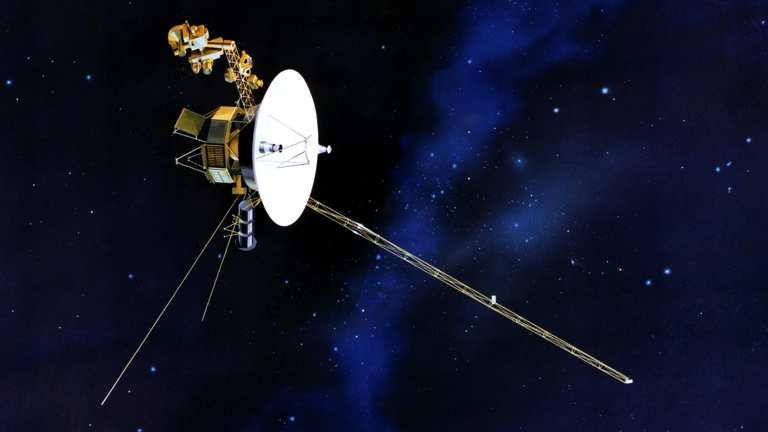
We finally know why NASA's Voyager 1 spacecraft stopped communicating — scientists are working on a fix
The first spacecraft to explore beyond the solar system started spouting gibberish late last year. Now, NASA knows why.

NASA engineers have discovered the cause of a communications breakdown between Earth and the interstellar explorer Voyager 1. It would appear that a small portion of corrupted memory exists in one of the spacecraft's computers.
The glitch caused Voyager 1 to send unreadable data back to Earth, and is found in the NASA spacecraft's flight data subsystem (FDS). That's the system responsible for packaging the probe's science and engineering data before the telemetry modulation unit (TMU) and radio transmitter send it back to mission control.
The source of the issue began to reveal itself when Voyager 1 operators sent the spacecraft a "poke" on March 3, 2024. This was intended to prompt FDS to send a full memory readout back to Earth.
The readout confirmed to the NASA team that about 3% of the FDS memory had been corrupted, and that this was preventing the computer from carrying out its normal operations.
Related: NASA finds clue while solving Voyager 1's communication breakdown case
Launched in 1977, Voyager 1 became the first human-made object to leave the solar system and enter interstellar space in 2012. Voyager 2 followed its spacecraft sibling out of the solar system in 2018, and is still operational and communicating well with Earth.
After 11 years of interstellar exploration, in Nov. 2023, Voyager 1's binary code — the computer language it uses to communicate with Earth — stopped making sense. Its 0's and 1's didn't mean anything anymore.
Get the Space.com Newsletter
Breaking space news, the latest updates on rocket launches, skywatching events and more!
"Effectively, the call between the spacecraft and the Earth was still connected, but Voyager's 'voice' was replaced with a monotonous dial tone," Voyager 1's engineering team previously told Space.com .

The team strongly suspects this glitch is the result of a single chip that's responsible for storing part of the affected portion of the FDS memory ceasing to work.
Currently, however, NASA can’t say for sure what exactly caused that particular issue. The chip could have been struck by a high-speed energetic particle from space or, after 46 years serving Voyager 1, it may simply have worn out.
— Voyager 2: An iconic spacecraft that's still exploring 45 years on
— NASA's interstellar Voyager probes get software updates beamed from 12 billion miles away
— NASA Voyager 2 spacecraft extends its interstellar science mission for 3 more years
Voyager 1 currently sits around 15 billion miles (24 billion kilometers) from Earth, which means it takes 22.5 hours to receive a radio signal from it — and another 22.5 hours for the spacecraft to receive a response via the Deep Space Network's antennas. Solving this communication issue is thus no mean feat.
Yet, NASA scientists and engineers are optimistic they can find a way to help FDS operate normally, even without the unusable memory hardware.
Solving this issue could take weeks or even months, according to NASA — but if it is resolved, Voyager 1 should be able to resume returning science data about what lies outside the solar system.
Join our Space Forums to keep talking space on the latest missions, night sky and more! And if you have a news tip, correction or comment, let us know at: [email protected].

Robert Lea is a science journalist in the U.K. whose articles have been published in Physics World, New Scientist, Astronomy Magazine, All About Space, Newsweek and ZME Science. He also writes about science communication for Elsevier and the European Journal of Physics. Rob holds a bachelor of science degree in physics and astronomy from the U.K.’s Open University. Follow him on Twitter @sciencef1rst.
SpaceX launches advanced weather satellite for US Space Force (video)
SpaceX launches 23 Starlink satellites in nighttime liftoff (photos, video)
SpaceX to launch a Falcon 9 rocket first stage for a record 20th time tonight
- jcs Funny timing for this article, when I am streaming an old Star Trek movie. So, surely this didn't cause a 3 byte glitch removing the O, Y and A from Voyager's name buffer? Get it? Reply
- bwana4swahili It is quite amazing it has lasted this long in a space environment. Reply
bwana4swahili said: It is quite amazing it has lasted this long in a space environment.
- HankySpanky So now we know even better for next time. Perhaps a spare chipset that is not redundant but is ready to take over, stored in a protective environment. A task NASA can handle. We'll find out in 100 year or so - if humanity still exists. Reply
HankySpanky said: So now we know even better for next time. Perhaps a spare chipset that is not redundant but is ready to take over, stored in a protective environment. A task NASA can handle. We'll find out in 100 year or so - if humanity still exists.
- Classical Motion I'm afraid it might self repair. And download galactic knowledge, then decide we are a danger. And turn around. Reply
Classical Motion said: I'm afraid it might self repair. And download galactic knowledge, then decide we are a danger. And turn around.
- jcs ROFLOL! And a hot bald chick delivering the bad news! Reply
- View All 8 Comments
Most Popular
- 2 Fallout and the Space Age: The franchise's connections and nods to the final frontier
- 3 Sierra Space wants to drop cargo from orbit to anywhere on Earth in 90 minutes
- 4 DJI Avata 2 drone review
- 5 Scientists identify origin of the 'BOAT' — the brightest cosmic blast of all time

- The Contents
- The Making of
- Where Are They Now
- Frequently Asked Questions
- Q & A with Ed Stone
golden record
Where are they now.
- frequently asked questions
- Q&A with Ed Stone
Mission Status
Instrument status.

Where are the Voyagers now?
To learn more about Voyager, zoom in and give the spacecraft a spin. View the full interactive experience at Eyes on the Solar System . Credit: NASA/JPL-Caltech
View Voyager
Space Flight Operations Schedule (SFOS)
SFOS files showing Voyager activity on Deep Space Network (DSN)
2024 Tracking Schedule
2023 tracking schedule, 2022 tracking schedule, 2021 tracking schedule, 2020 tracking schedule, 2019 tracking schedule, 2018 tracking schedule, 2017 tracking schedule, 2016 tracking schedule, 2015 tracking schedule, 2014 tracking schedule, 2013 tracking schedule, 2012 tracking schedule, 2011 tracking schedule, 2010 tracking schedule, 2009 tracking schedule, 2008 tracking schedule, 2007 tracking schedule, 2006 tracking schedule, 2005 tracking schedule, 2004 tracking schedule, 2003 tracking schedule, 2002 tracking schedule, 2001 tracking schedule, 2000 tracking schedule, 1999 tracking schedule, 1998 tracking schedule, 1997 tracking schedule, 1996 tracking schedule, 1995 tracking schedule, 1994 tracking schedule.
- Celebrities
- Science & Tech
- Fashion & Beauty
- Food & Drink
- Home & Garden
- Sports & Fitness
- Travel & Outdoors
- Science & tech
- Conversations
NASA spacecraft is transmitting mysterious 'gibberish' from outside our solar system
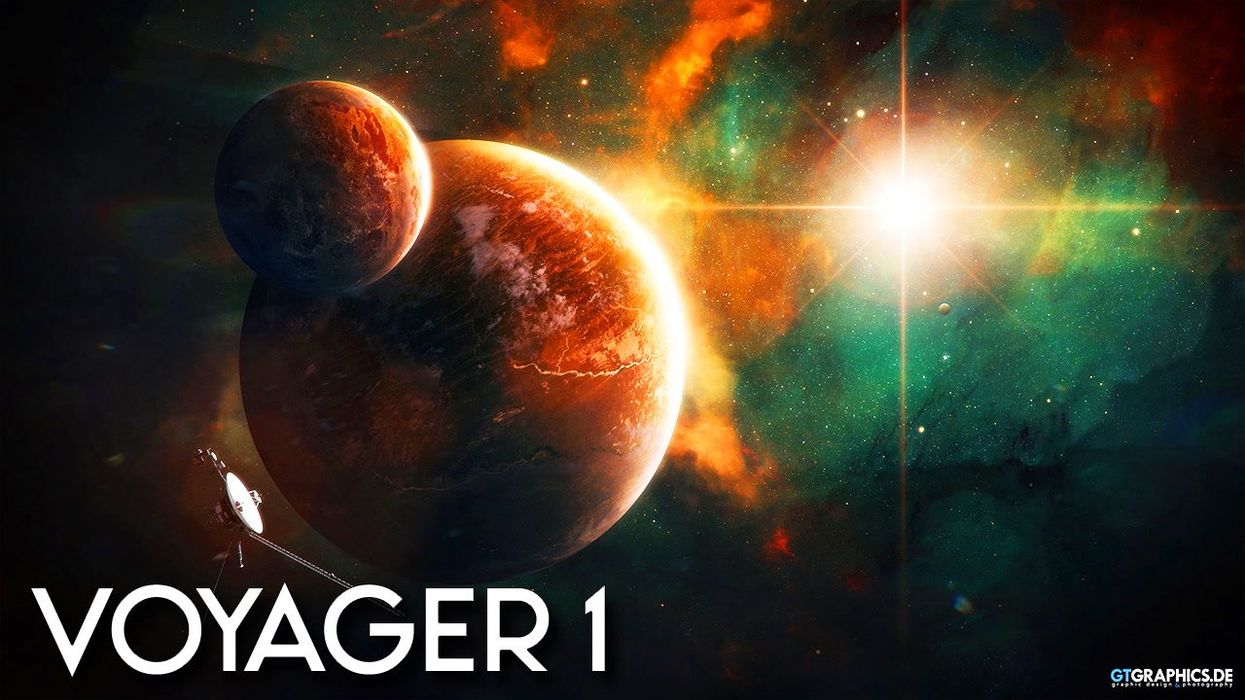
NASA engineers have finally got to the bottom of why its Voyager 1 craft is emitting a stream of garbled nonsense.
The space probe was launched by NASA on 5 September 1977 as part of the space agency’s mission to explore the outer Solar System. It is one of two Voyager probes that were sent to space with artefacts of Earth onboard and is now 15 billion miles (24 billion kilometres) from Earth.
As it drifts further from us, the Voyager 1 spacecraft sends regular radio signals. But, since November, it has been emitting a stream of gibberish back to Earth that is completely unreadable and experts now think they know why.
In March, engineers sent what is known as a “poke” to the probe to get information from its flight data subsystem (FDS). From its response, they concluded that the likely problem is that the memory of the FDS has been corrupted.
NASA explained the situation in a blog post, writing : “The team suspects that a single chip responsible for storing part of the affected portion of the FDS memory isn’t working. Engineers can’t determine with certainty what caused the issue.
“Two possibilities are that the chip could have been hit by an energetic particle from space or that it simply may have worn out after 46 years.”
The solution could take months to implement, however, engineers believe they are able to run the FDS without the damaged chip. Once it is working, it is hoped the Voyager 1 will once again be able to send its regular radio signals, from outside our solar system, that are actually readable.
Sign up f or our free indy100 weekly newsletter
How to join the indy100's free WhatsApp channel
Have your say in our news democracy. Click the upvote icon at the top of the page to help raise this article through the indy100 ranking
Is the radiation from a solar eclipse bad for you?
Gta 6 - live updates as troy baker dismisses jason links, joe rogan suggests key bible prophet was actually just high on drugs, the hardest geezer's run across africa in numbers, surprising details undercovered in conjoined twin abby hensel's wedding documents, larry david’s 20 funniest ever curb your enthusiasm quotes, usain bolt's ancient running record destroyed by high-schooler, the rock turns on joe biden and refuses to endorse him for president, what is a 'honey trap', plants 'scream' while they're being harvested, internet finds husband who ghosted wife and kids in less than 24 hours, 'disgusting' diddy nickelodeon cameo resurfaces following house raid, giant lake suddenly reappears 130 years after vanishing, all of the celebrities who have made claims about diddy.

IMAGES
VIDEO
COMMENTS
The Voyager message is carried by a phonograph record, a 12-inch gold-plated copper disk containing sounds and images selected to portray the diversity of life and culture on Earth. Launched in 1977, both Voyager spacecraft began a historic journey and each carried a unique 'time capsule' along with them. Click to learn more.
The Voyager Golden Records are two identical phonograph records which were included aboard the two Voyager spacecraft launched in 1977. ... The record also includes a printed message from U.S. president Jimmy Carter. The collection of images includes many photographs and diagrams both in black and white, and color. The first images are of ...
The Voyager Golden Record contains 116 images and a variety of sounds. The items for the record, which is carried on both the Voyager 1 and Voyager 2 spacecraft, were selected for NASA by a committee chaired by Carl Sagan of Cornell University.Included are natural sounds (including some made by animals), musical selections from different cultures and eras, spoken greetings in 59 languages ...
The "Golden Record" would be an upgrade to Pioneer's plaques. Mounted on Voyager 1 and Voyager 2, twin probes launched in 1977, the two copies of the record would serve as time capsules and ...
Message in a Bottle: Directed by Nancy Malone. With Kate Mulgrew, Robert Beltran, Roxann Dawson, Robert Duncan McNeill. Using an alien communications net, Voyager sends their Doctor to the Federation ship USS Prometheus only to find that it has been taken over by Romulans.
Star Trek Voyager - Season 4 Episode 14 - Message In A Bottle - The Doctor Returns To Voyager With A Message From Starfleet
Star Trek: Voyager. ) " Message in a Bottle " is the 14th episode of the fourth season of the American science fiction television series Star Trek: Voyager, the 82nd episode overall. It aired on January 21, 1998 on the UPN network. Set in the 24th century, the series follows the adventures of the Starfleet and Maquis crew of the starship USS ...
Voyager 1 was the first spacecraft to cross the heliosphere, the boundary where the influences outside our solar system are stronger than those from our Sun. ... Each of the Voyagers contain a "message," prepared by a team headed by Carl Sagan, in the form of a 12-inch (30 cm) diameter gold-plated copper disc for potential extraterrestrials ...
An intergalactic message in a bottle, the Voyager Golden Record was launched into space late in the summer of 1977. Conceived as a sort of advance promo disc advertising planet Earth and its inhabitants, it was affixed to Voyager 1 and Voyager 2, spacecraft designed to fly to the outer reaches of the solar system and beyond, providing data and documentation of Saturn, Uranus, Neptune, and Pluto.
Transcript. Forty years ago, NASA launched two Voyager spacecraft into deep space. Onboard both were gold discs with music, greetings and sounds from Earth — a message to aliens. Ann Druyan, the ...
The message is carried by a phonograph record - -a 12-inch gold-plated copper disk containing sounds and images selected to portray the diversity of life and culture on Earth. In August 2012, Voyager 1 made the historic entry into interstellar space, the region between stars, filled with material ejected by the death of nearby stars millions of ...
Review Text. Nutshell: Quite a bit of fun, but not everything it should've been under the circumstances. There are a lot of elements in "Message in a Bottle" that epitomize what has obviously become the statement of Voyager's fourth season as a whole—namely, that Voyager is a faster, funnier, snappier, and generally better series all around, but that the stories are primarily lightweight ...
Voyager's Golden Record. NASA's twin Voyager spacecraft launched in August and September 1977. Aboard each spacecraft is a golden record, a collection of sights, sounds and greetings from Earth ...
Message in a Bottle also comes at the half-way point in Voyager's run, speaking in terms of structure rather than episode count.Message in a Bottle is positioned mid-way through the middle season of Voyager's seven year run.Although the count is skewed somewhat by the series' abridged first season, it feels like the last point at which Voyager is closer to its beginning than to its end.
Updating the 'message in a bottle' to aliens: Do we need a new Golden Record? A team of researchers thinks a 21st century upgrade is in order decades after NASA's twin Voyager probes launched with ...
Seven of Nine finds an abandoned subspace relay network that has the ability to send a message, or in this case The Doctor, to a Starfleet ship detected in the Alpha Quadrant. Lieutenant B'Elanna Torres and Commander Chakotay discuss Torres' dissatisfaction with the former Borg drone, Seven of Nine. Torres has run out of patience with Seven's aloof, arrogant attitude and is furious. Chakotay ...
Opinionated Voyager Episode Guide continues it's season 4 sampler with Message in a Bottle. We shoot the Doctor across the galaxy in a network, fearful that ...
Voyager 1 is currently the farthest human-made object from Earth. This humble piece of technology has now reached interstellar space. The message it carries is a bold message to the void of space ...
A 12-inch gold plated copper disk containing recorded sounds and images representing human cultures and life on Earth, is affixed to each Voyager - a message in a bottle cast into the cosmic sea. The recorded material was selected by a committee chaired by the late Carl Sagan . Simple diagrams on the cover (visible above) represent symbolically ...
Message in a Bottle. Voyager, lost in the unexplored reaches of the Delta Quadrant, has been searching for a way back to the Alpha Quadrant for years. In the episode "Message in a Bottle," their efforts take an unexpected turn when they pick up a faint Starfleet signal from a distant planet.
Related: NASA's Voyager 1 sends readable message to Earth after 4 nail-biting months of gibberish ... Voyager 1 is currently more than 15 billion miles (24 billion kilometers) from Earth, and it ...
Voyager 1 is escaping the solar system at a speed of about 3.5 AU per year, 35 degrees out of the ecliptic plane to the north, in the general direction of the solar apex (the direction of the sun's motion relative to nearby stars). Voyager 1 will leave the solar system aiming toward the constellation Ophiuchus.
For months, NASA's Voyager team has been struggling to translate garbled messages from beyond our solar system. Voyager 1 has been responding to NASA's data requests with tangles of 1s and 0s ...
For months now, the most distant spacecraft to Earth - Voyager 1 - has been talking gibberish on the interplanetary 'radio'. The repetitive jumble of 1s and 0s it's sending back to our planet, 24 billion kilometers (15 billion miles) away, has made no sense to scientists until now. Turns out, officials at NASA just needed to give the oh-so ...
In November 2023, the first spacecraft to journey to interstellar space, Voyager 1, started spouting gibberish. Now, NASA knows why. The team is working on a fix.
In the NASA Eyes on the Solar System app, you can see the real spacecraft trajectories of the Voyagers, which are updated every five minutes. Distance and velocities are updated in real-time. For a full 3D, immersive experience click on View Voyagers link below to launch the NASA Eyes on the Solar System app. View Voyager.
It is one of two Voyager probes that were sent to space with artefacts of Earth onboard and is now 15 billion miles (24 billion kilometres) from Earth. As it drifts further from us, the Voyager 1 spacecraft sends regular radio signals. But, since November, it has been emitting a stream of gibberish back to Earth that is completely unreadable ...
NASA hasn't fixed Voyager 1 yet, but engineers now know what's vexing the spacecraft. The glitch paused Voyager 1's science work and kicked off a long-distance diagnosis process. The team ...